Behavioral Science I: Lesson 4: Olfaction, Gustation and Consciousness
1/72
There's no tags or description
Looks like no tags are added yet.
Name | Mastery | Learn | Test | Matching | Spaced |
|---|
No study sessions yet.
73 Terms
Which type of molecules are known to act on specialized olfactory cells, and are chemical signals released by a member of a species and sensed by another member of the same species?
(A) Nasal Cells
(B) Basal Cells
(C) Apical Cells
(D) Pheromones
(D) Pheromones
Pheromones are known to act on specialized olfactory cells, and are chemical signals released by a member of a species and sensed by another member of the same species
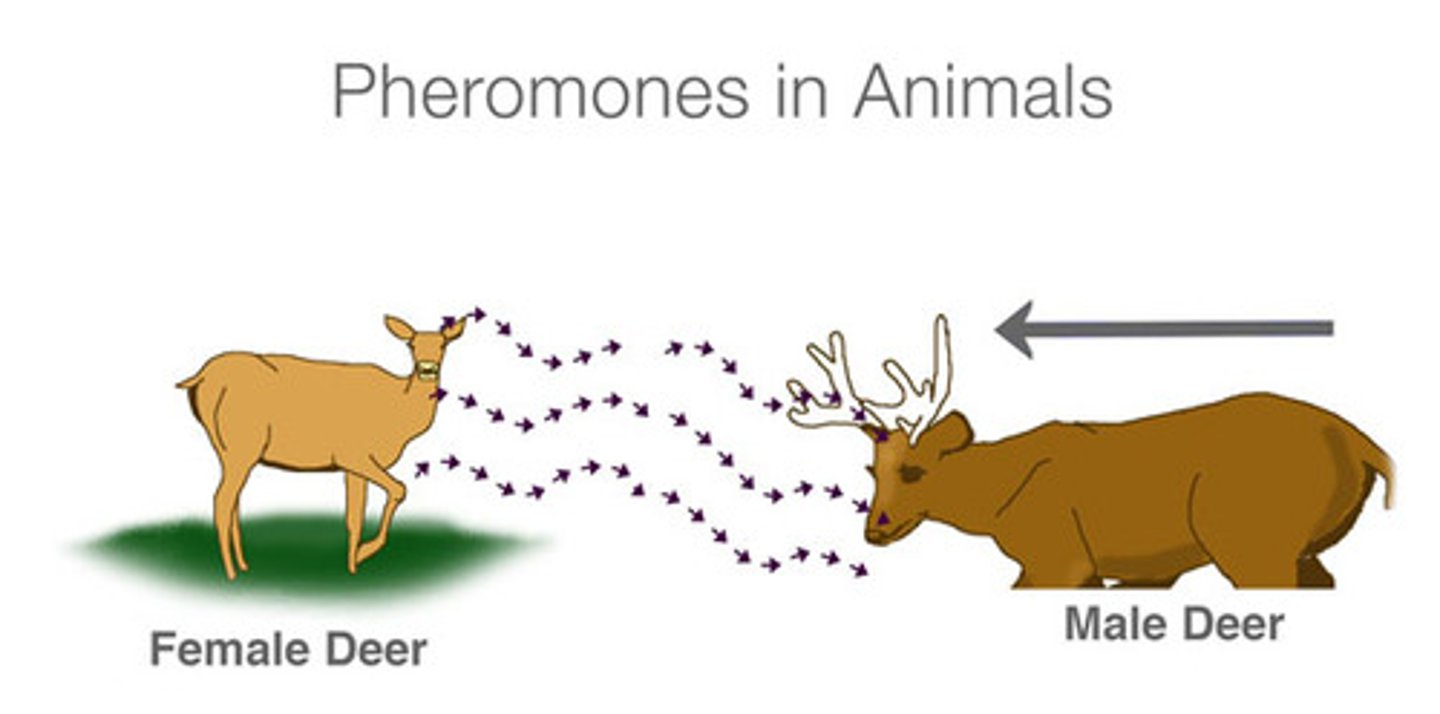
True or False? Pheromones trigger an innate response in animals/insects and thus are important and linked to mating, fighting, and communication.
True. Pheromones trigger an innate response in animals/insects and thus are important and linked to mating, fighting, and communication.
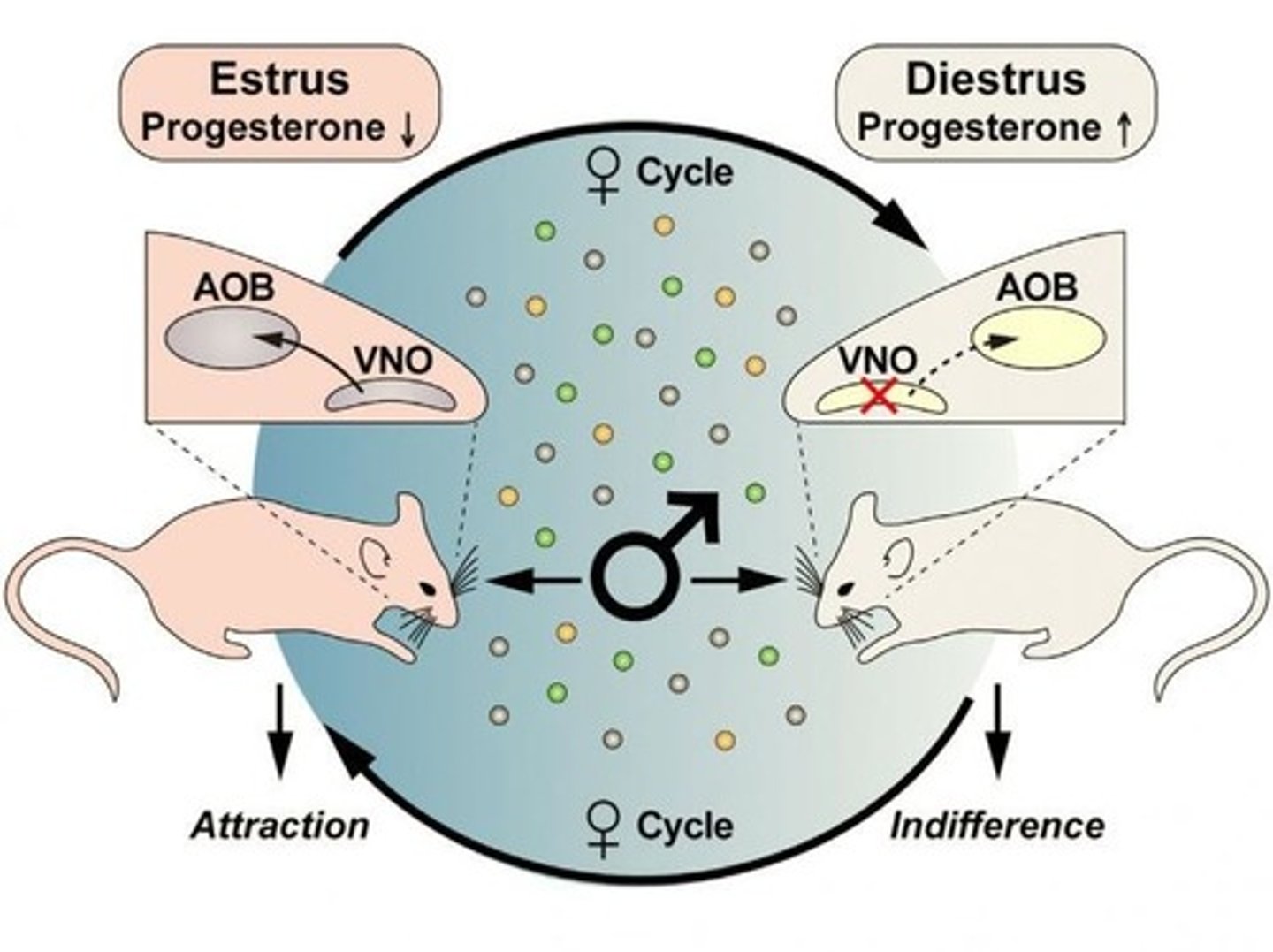
The specialized part of the olfactory epithelium in animals is known as the ____________, that sends projections to the accessory olfactory bulb which is then processed by the brain.
(A) Olfactory bulb
(B) Basal Cell
(C) Accessory Olfactory Epithelium
(D) Vomeronasal System
(C) Accessory Olfactory Epithelium
The specialized part of the olfactory epithelium in animals is known as the Accessory Olfactory Epithelium, that sends projections to the accessory olfactory bulb which is then processed by the brain.
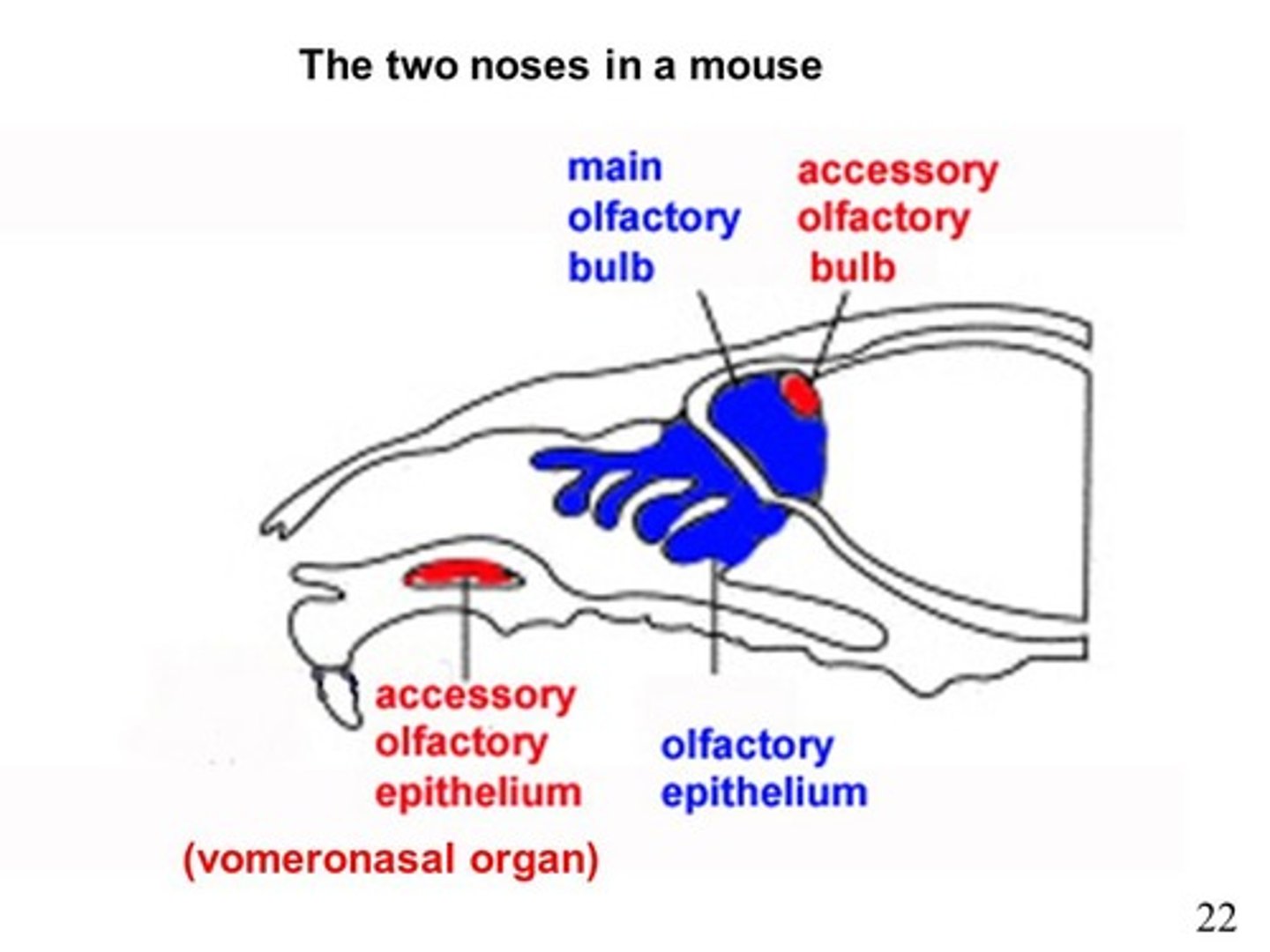
What structure is present within the accessory olfactory epithelium?
(A) Vomeronasal System
(B) Olfactory Bulb
(C) Accessory Olfactory Bulb
(D) Cribriform Plate
(A) Vomeronasal System
The Vomeronasal System is present with the accessory olfactory epithelium.
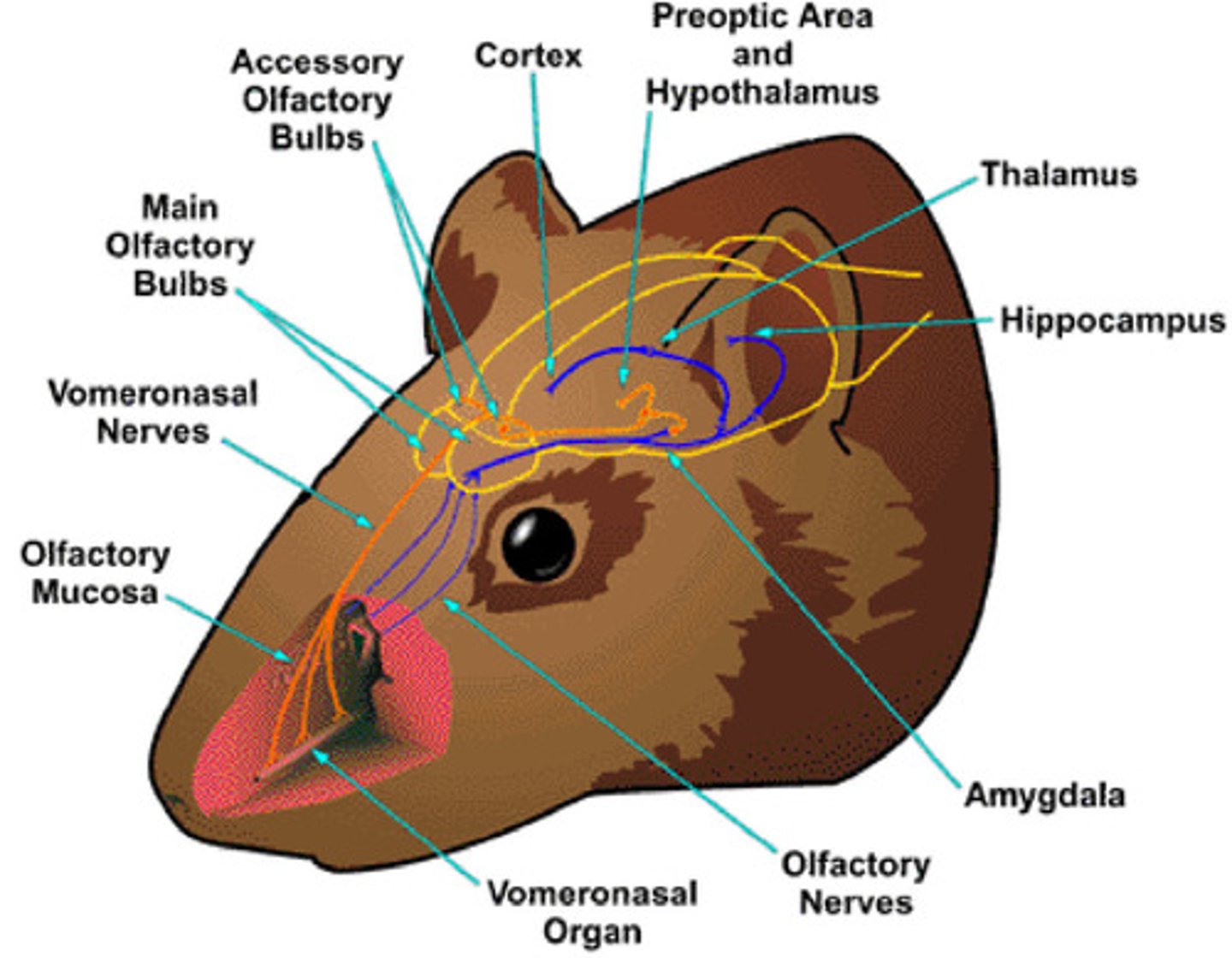
Which cells in the vomeronasal system are responsive to pheromones?
(A) Olfactory Cells, Nasal Cells
(B) Basal Cells, Apical Cells
(C) Basal Cells, Nasal Cells
(D) Olfactory Cells, Apical Cells
(B) Basal Cells, Apical Cells
The Basal and Apical Cells in the vomeronasal system are responsive to pheromones.
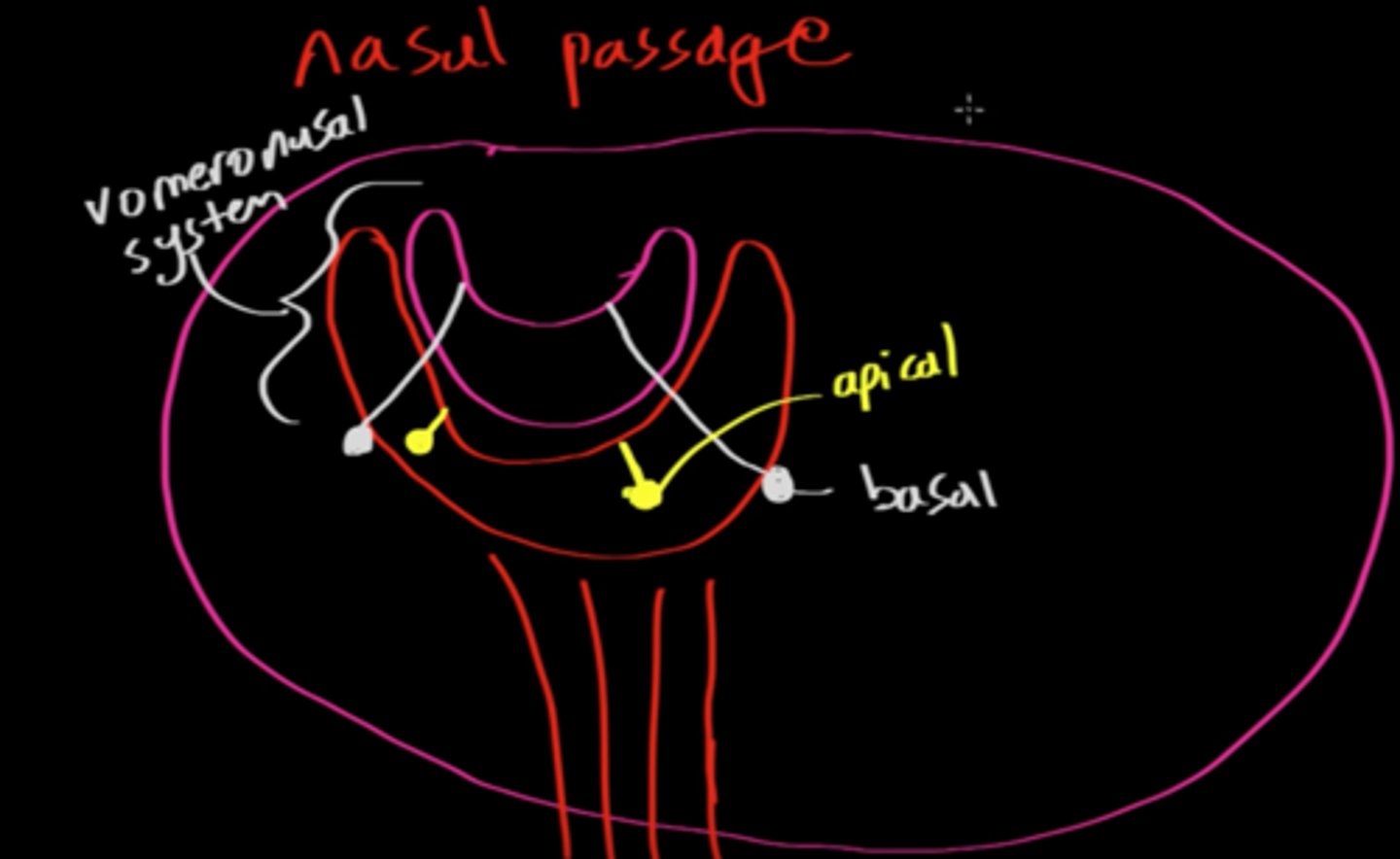
Place the following steps in order from first to last:
I. Signal synapses on to the glomerulus.
II. Basal/apical cell sends axon through accessory olfactory epithelium to the accessory olfactory bulb.
III. Pheromone molecule activates receptor on basal/apical cell.
IV. Signal is sent to the amygdala where it is processed.
V. Signal is sent to the mitral or tufted cell.
(A) I > II > III > IV > V
(B) III > II > I > V > IV
(C) II > I > III > IV > V
(D) III > II > I > IV > V
(B) III > II > I > V > IV
III. Pheromone molecule activates receptor on basal/apical cell. ->
II. Basal/apical cell sends axon through accessory olfactory epithelium to the accessory olfactory bulb. ->
I. Signal synapses on to the glomerulus. ->
V. Signal is sent to the mitral or tufted cell. ->
IV. Signal is sent to the amygdala where it is processed.
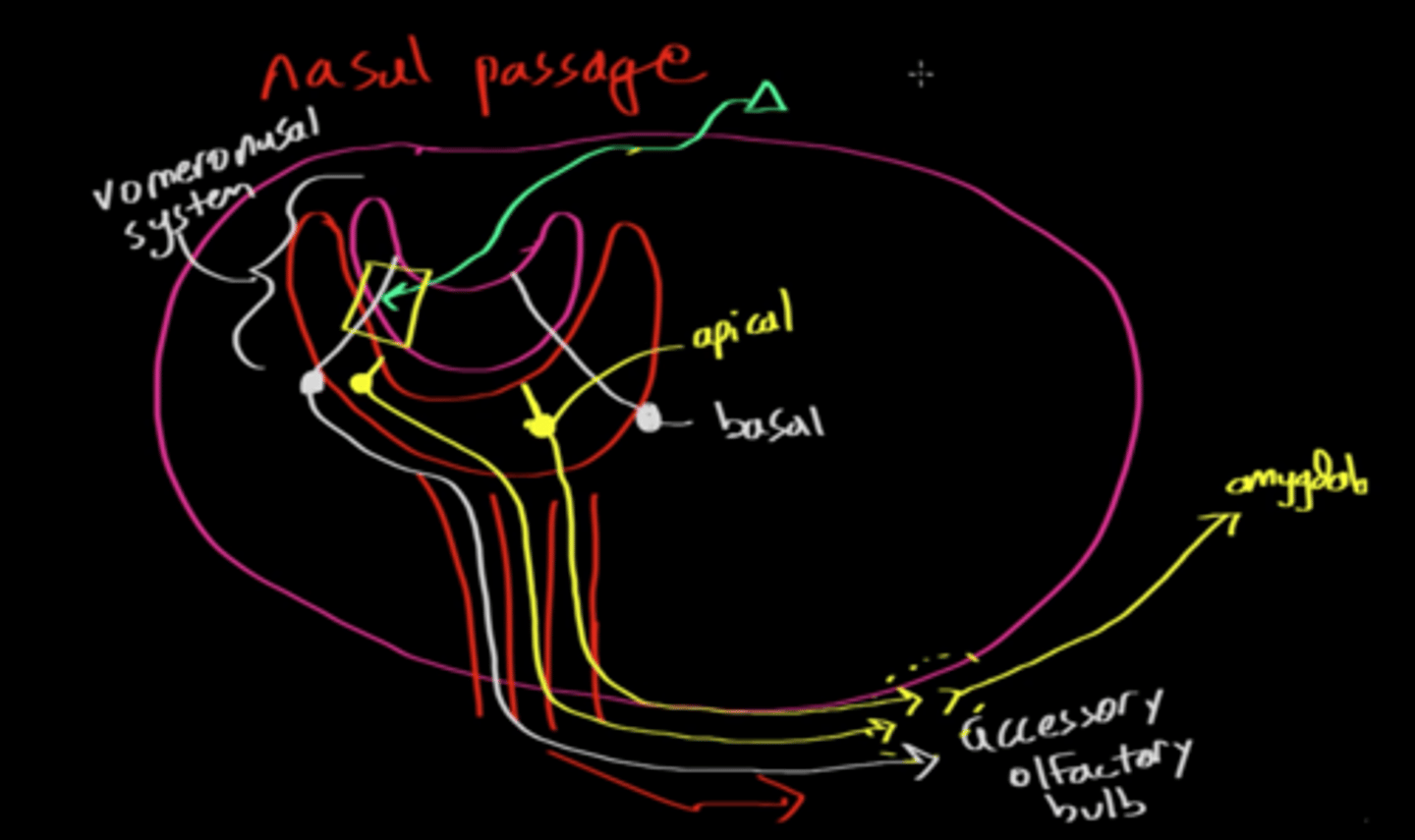
CRB Based on the previous description, which class of receptors detect pheromones?
(A) Mechanoreceptors
(B) Chemoreceptors
(C) Voltage Gated Receptors
(D) Intracellular Receptors
(B) Chemoreceptors
These chemoreceptors recognize the pheromones to cause any downstream signaling.
Why do humans rely very little on pheromones? Which structure in the human olfactory system is not present that is present in other animals that rely on pheromones?
Humans do not have an Accessory Olfactory Bulb. Without an Accessory Olfactory Bulb, pheromones cannot be processed by the brain as effectively as an animal that does have an accessory olfactory bulb (ex: a mouse).
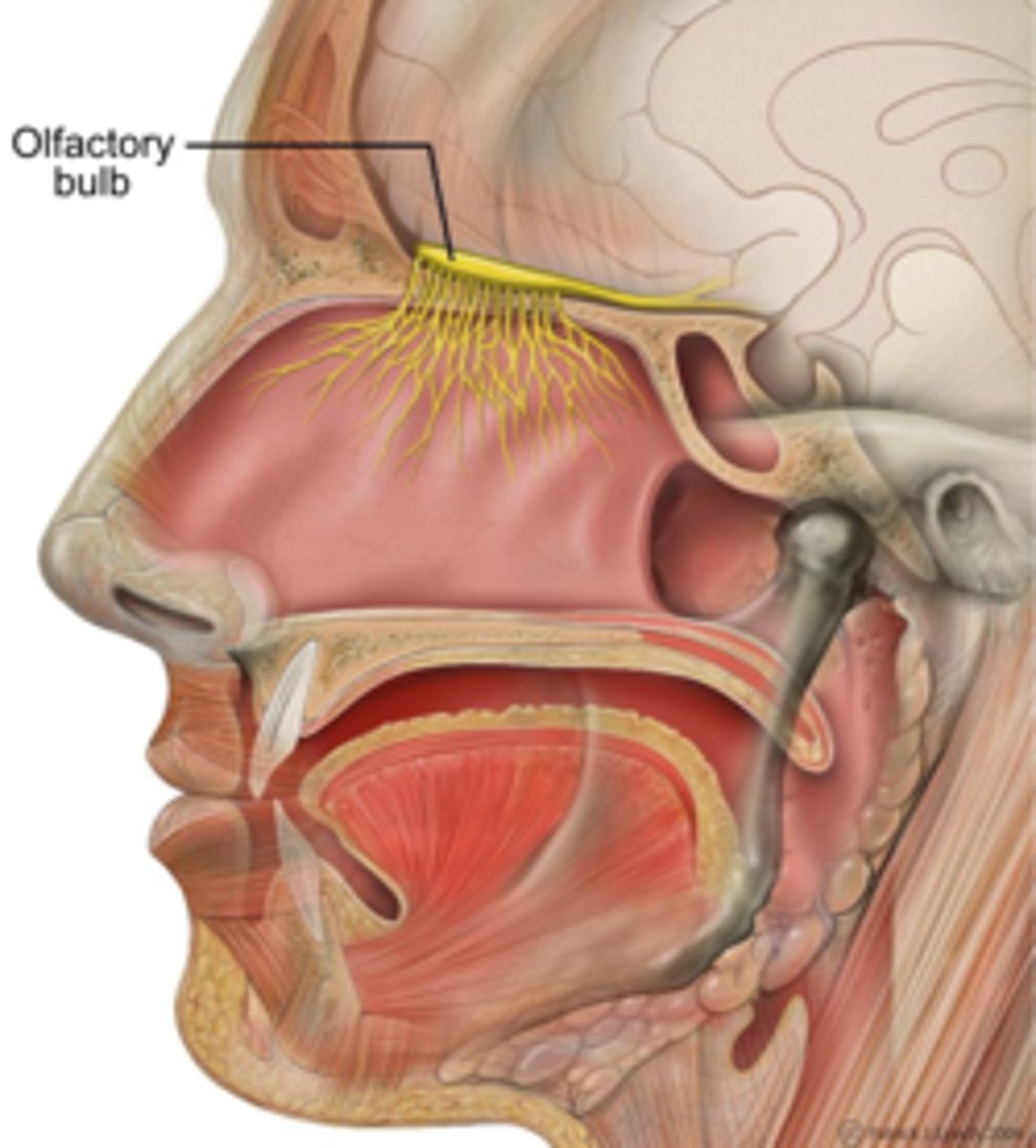
Why is that when one has a cold and their nose is stuffy, their sense of taste is diminished?
When someone eats, molecules travel to the back of the throat and nose, so when eating one's sense of taste is being used in conjunction with one's sense of smell. When someone has a cold, their sense of smell is knocked out, therefore diminishing their sense of taste.
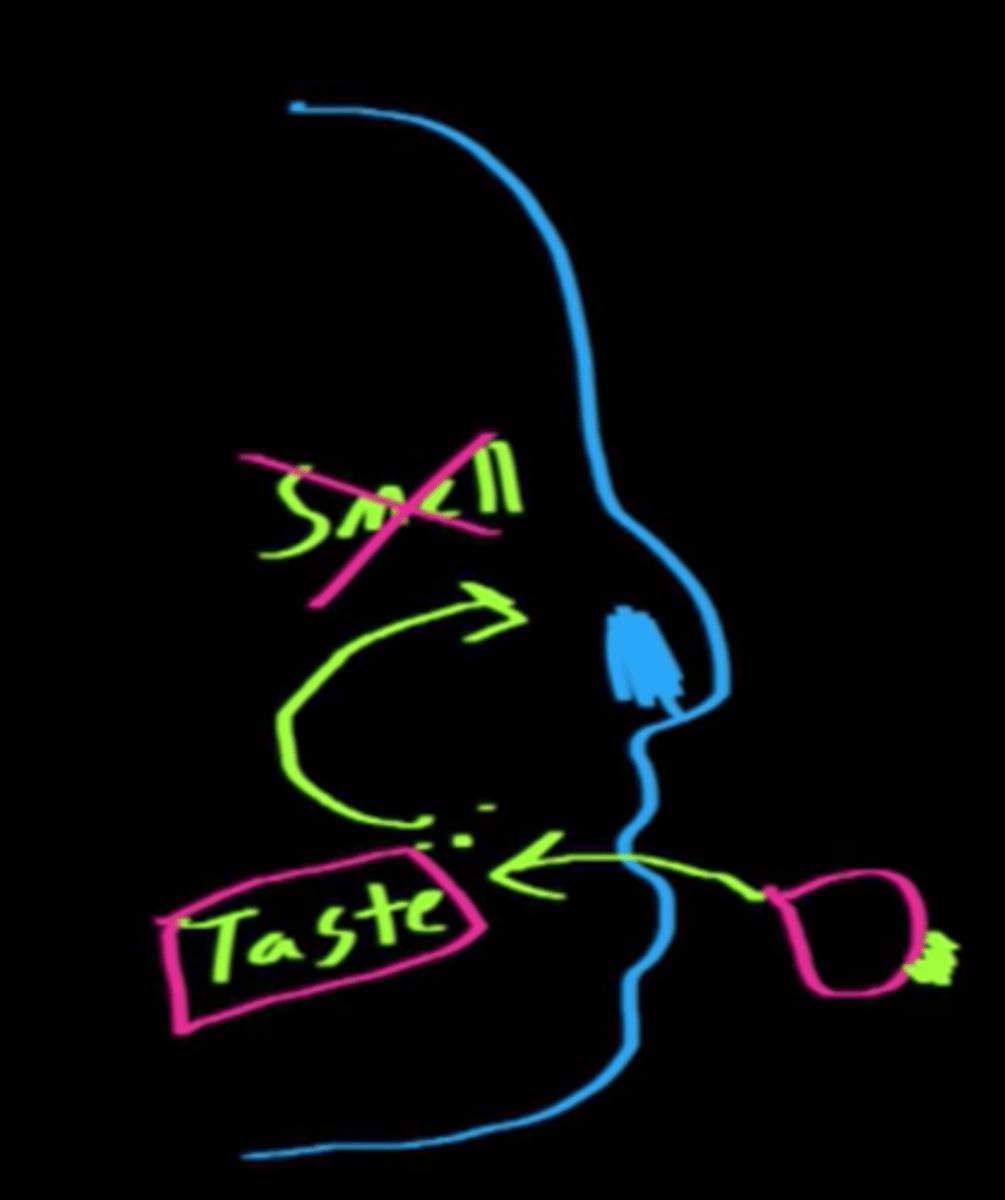
What is the common name for olfaction?
(A) Smell
(B) Taste
(C) Hearing
(D) Sight
(A) Smell
Smell is the common name for olfaction.
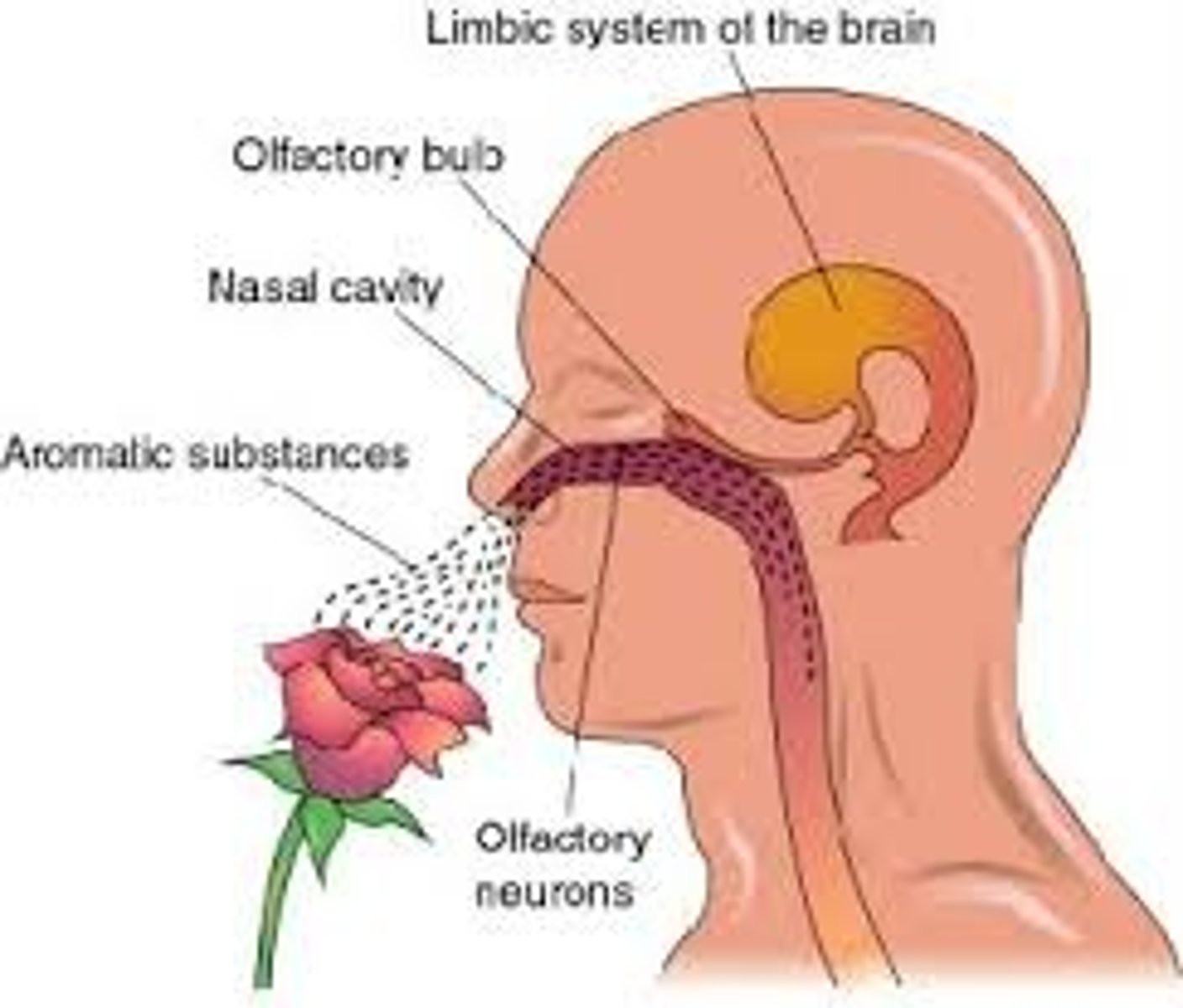
Which structure, lined with tiny holes, separates the olfactory epithelium from the human brain?
(A) Glomerulus
(B) Cribriform Plate
(C) Amygdala
(D) Vomeronasal System
(B) Cribriform Plate
The Cribriform Plate is lined with tiny holes and separates the olfactory epithelium from the human brain.
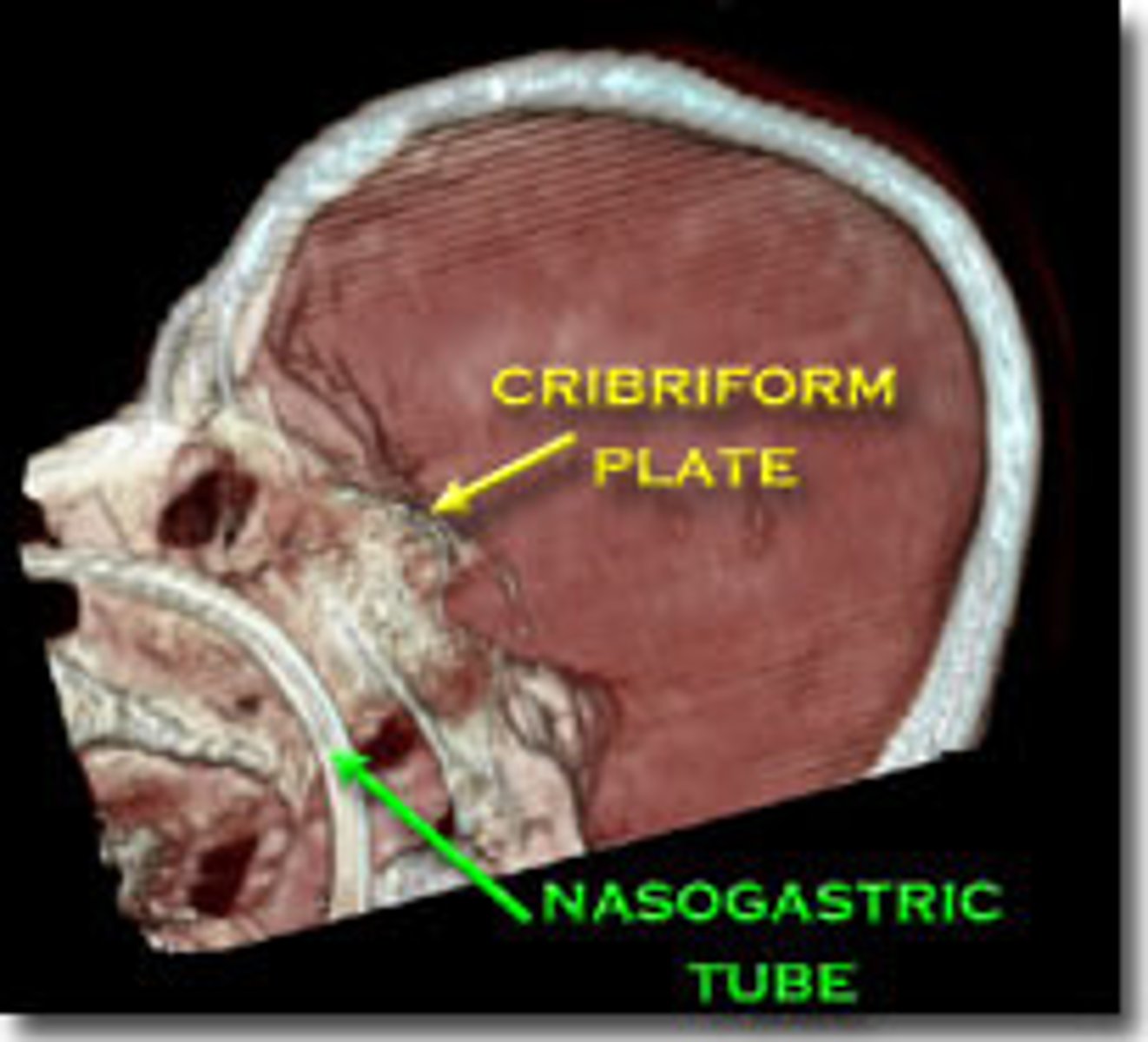
Which structure is a bundle of nerves that lies right above the cribriform plate that sends little nerve projections through the cribriform plate into the olfactory epithelium?
(A) Glomerulus
(B) Filiform Papillae
(C) Mitral Cell
(D) Olfactory Bulb
(D) Olfactory Bulb
The Olfactory Bulb is a bundle of nerves that lie right above the cribriform plate. The Olfactory Bulb sends little nerve projections through the cribriform plate to the olfactory epithelium.

True or False? At the end of each projection that the olfactory bulb sends through the cribriform plate to the olfactory epithelium, there are receptors that are sensitive to many molecules each.
False. At the end of each projection that the olfactory bulb sends through the cribriform plate to the olfactory epithelium, there are receptors that are sensitive to ONLY 1 MOLECULE each.
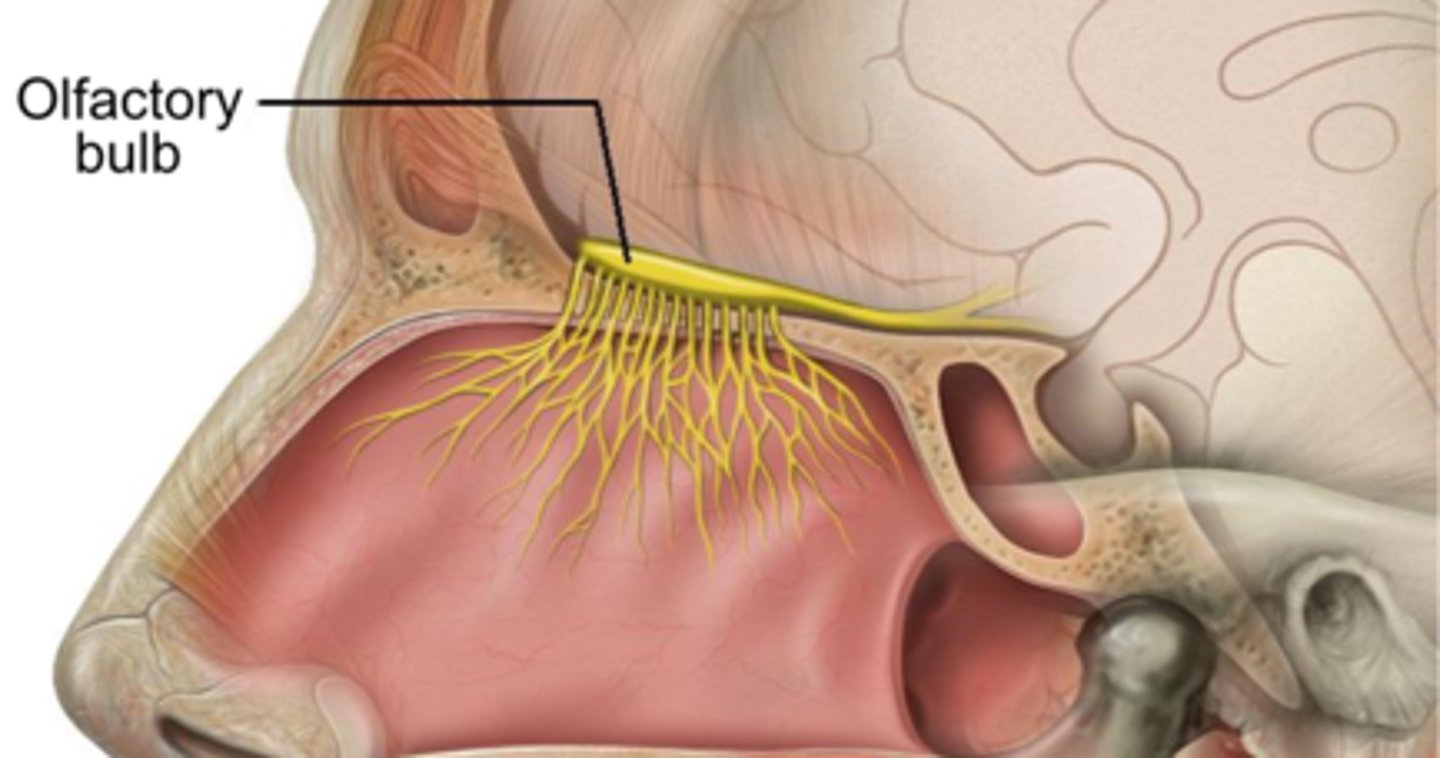
The cribriform plate of the ethmoid bone has many holes. What would happen if the cribriform plate were completely solid (no holes)?
Without holes, it would be much tougher for nerves from the olfactory bulb to connect to the olfactory epithelium. Without these nerve receptors present, the sense of smell would be impaired.
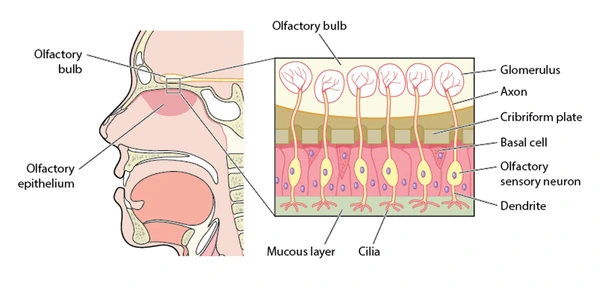
The _____________ is where various sensory olfactory cells, that are sensitive to the same molecule, synapse.
(A) Mitral/Tufted Cell
(B) Glomerulus
(C) Olfactory Epithelium
(D) Cribriform Plate
(B) Glomerulus
The Glomerulus is where various sensory olfactory cells, that are sensitive to the same molecule, synapse.
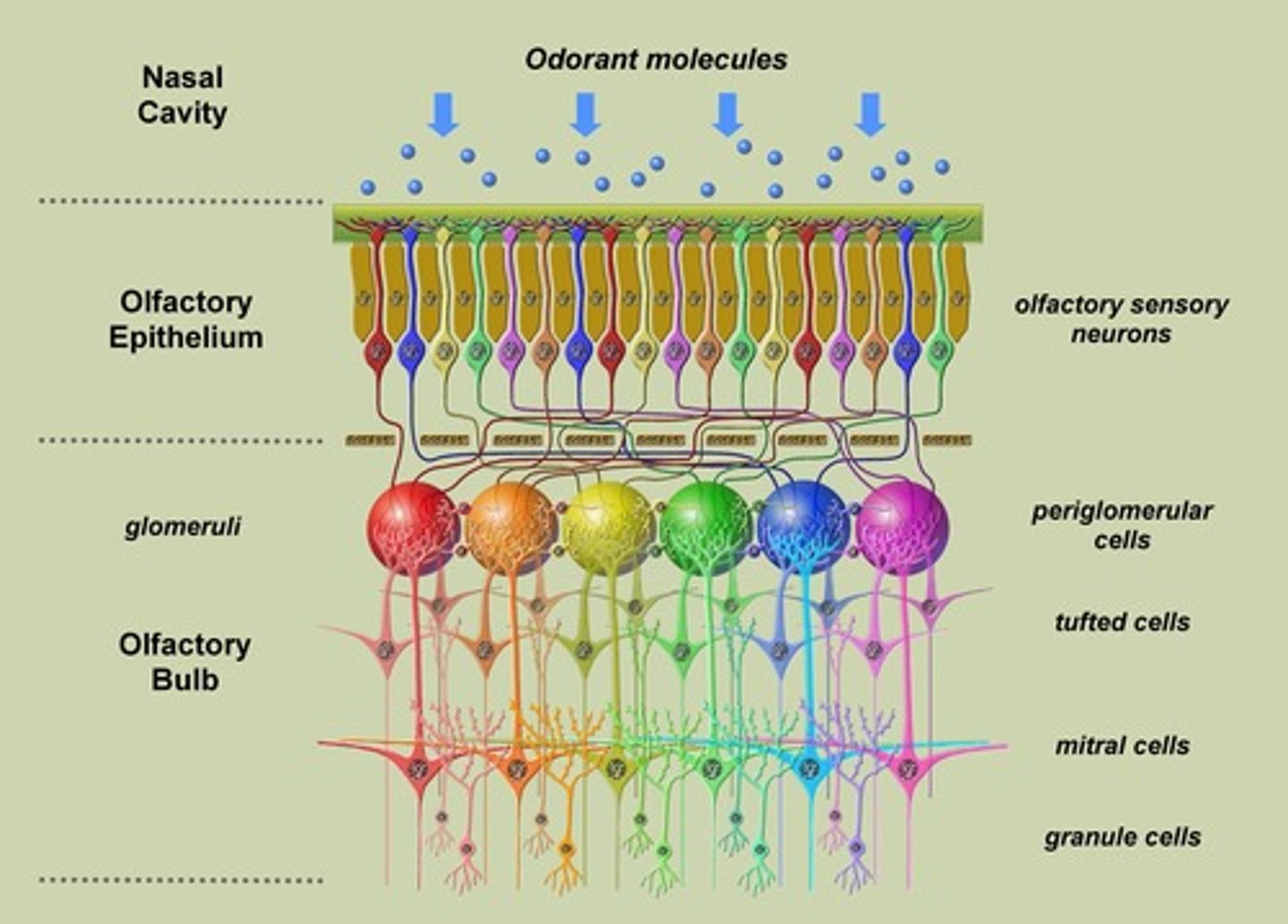
After olfactory cells synapse to their specific glomerulus, which structure, that projects to the brain, do the cells then travel to?
(A) Olfactory epithelium
(B) Cribriform Plate
(C) Mitral/Tufted Cell
(D) Amygdala
(C) Mitral/Tufted Cell
After olfactory cells synapse to their specific glomerulus, the cells then travel to the Mitral/Tufted Cell, which projects to the brain.
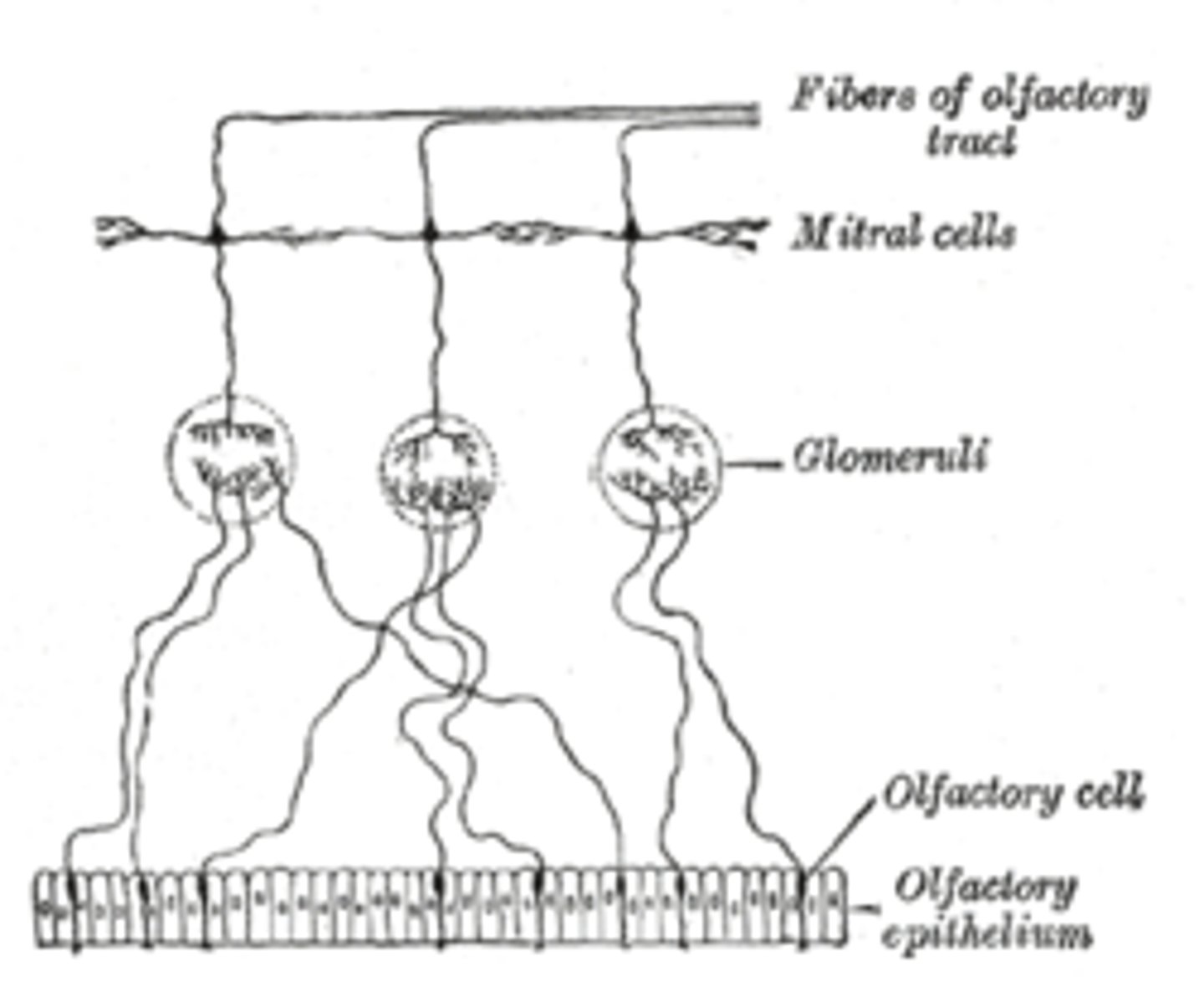
Put the following steps of an Action Potential in the Olfactory System in order:
I. Odor molecule binds to specific G-Protein Coupled Receptor (GPCR) in the olfactory epithelia.
II. G-Protein actions activate an ion channel which allows cations to enter through the membrane, and triggers and Action Potential.
III. G-Protein dissociates from Receptor.
IV. Action potential travels through the Cribriform Plate to the Glomerulus.
(A) I -> II -> III -> IV
(B) IV -> III -> II -> I
(C) IV -> II -> III -> I
(D) I -> III -> II -> IV
(D) I -> III -> II -> IV
Odor molecule binds to specific G-Protein Coupled Receptor (GPCR) in the olfactory epithelia -> G-Protein dissociates from Receptor -> G-Protein actions activate an ion channel which allows cations to enter through the membrane, and triggers and Action Potential -> Action potential travels through the Cribriform Plate to the Glomerulus
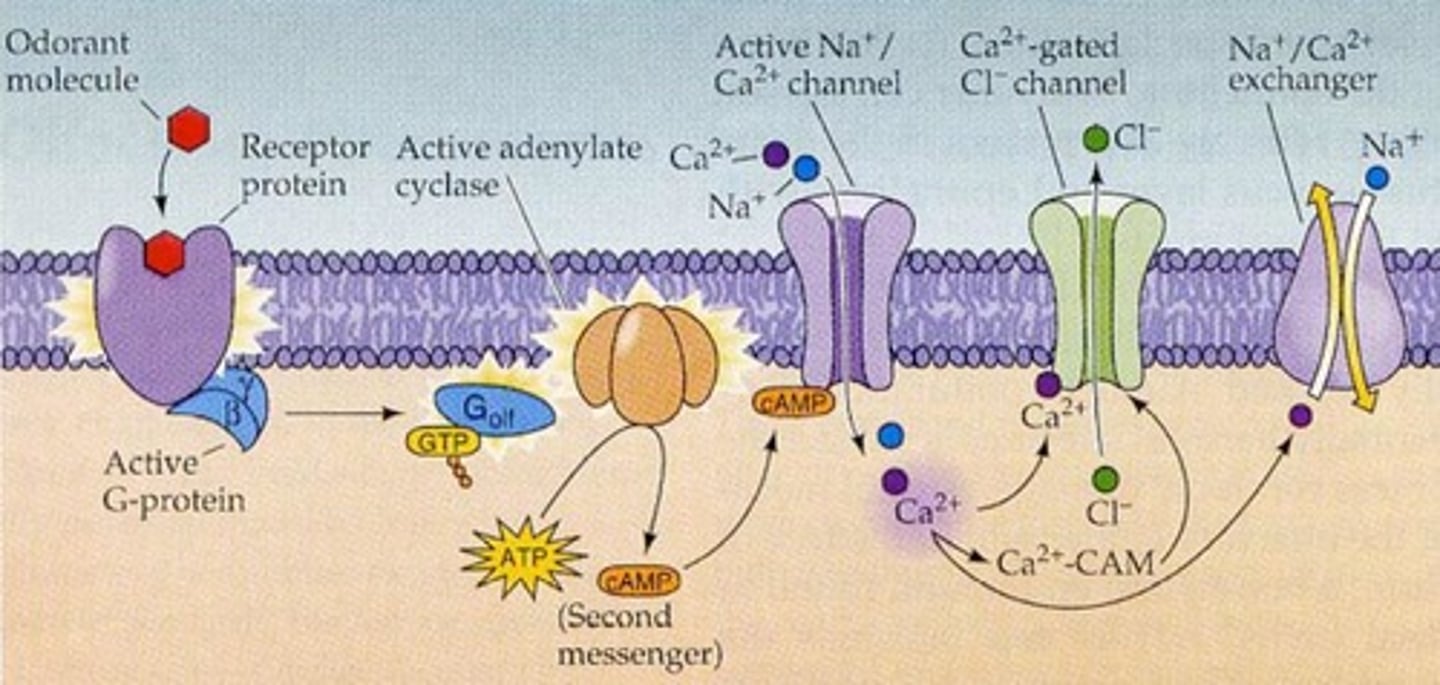
CRB True or false? Olfaction is the only sense that does not pass through the thalamus.
True. Olfaction is the only sense that does not pass through the thalamus. It instead passes unfiltered into higher-order brain centers.
CRB True or false? Association related to olfaction are completely learned; there are no innate feelings associated with any particular smells.
True. Association related to olfaction are completely learned; there are no innate feelings associated with any particular smells.
CRB Fill in the blanks: __________ is sensitive only to compounds travelling in gas, whereas _________ is sensitive to compounds dissolved in solids and/or liquids.
(A) Olfaction, Proprioception
(B) Olfaction, Gustation
(C) Gustation, Olfaction
(D) Proprioception, Olfaction
(B) Olfaction, Gustation
Olfaction is sensitive only to compounds travelling in gas, whereas Gustation is sensitive to compounds dissolved in solids and/or liquids.
________________ taste buds are mushroom shaped structures located primarily in the anterior portion of the tongue.
(A) Fungiform
(B) Foliate
(C) Circumvallate
(D) Filiform
(A) Fungiform
Fungiform taste buds are mushroom shaped structures located primarily in the anterior portion of the tongue.
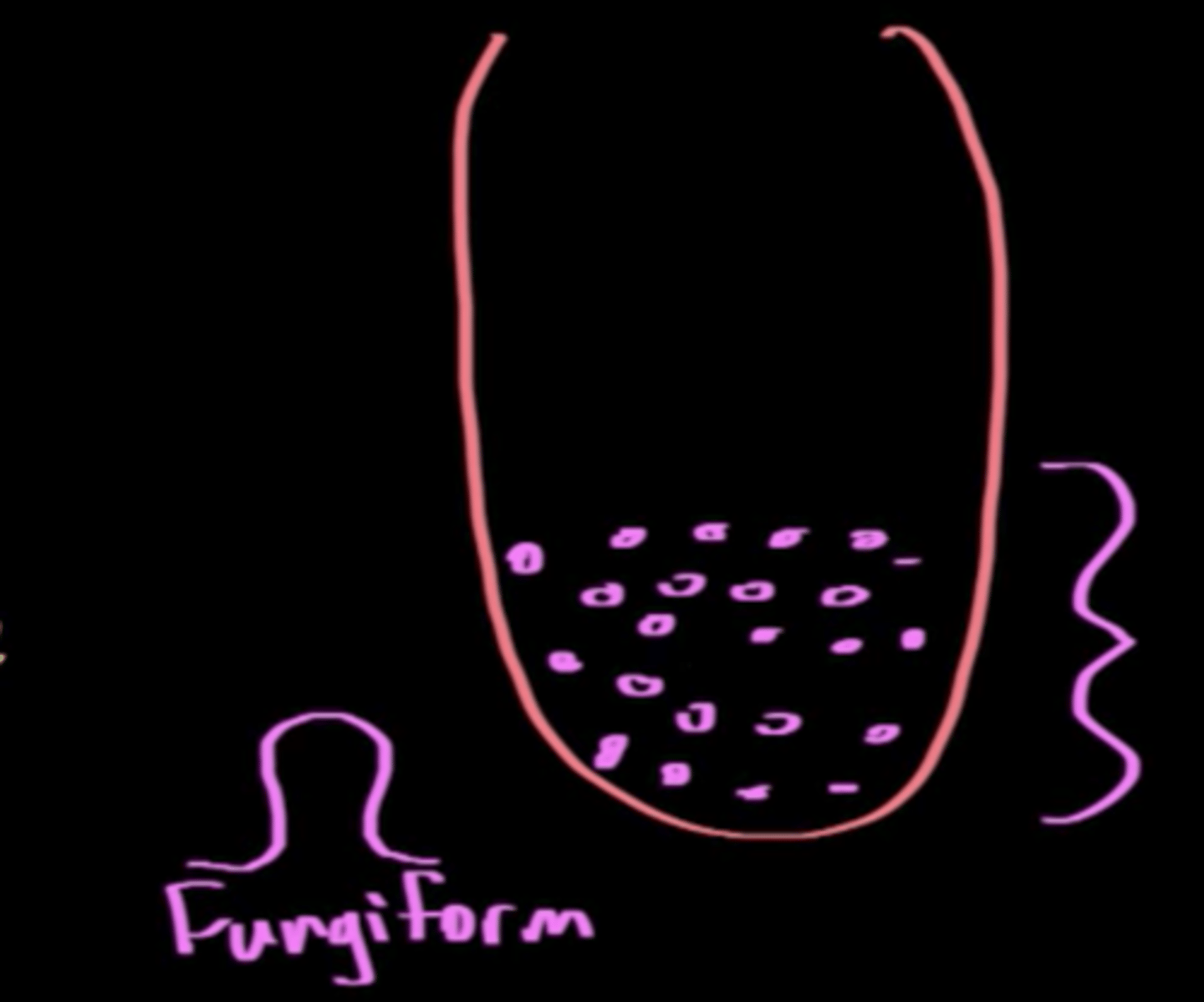
______________ taste buds are folded structures located primarily in the lateral (side) portions of the tongue.
(A) Fungiform
(B) Foliate
(C) Circumvallate
(D) Filiform
(B) Foliate
Foliate tasted buds are folded structures located primarily on the lateral (side) portions of the tongue.
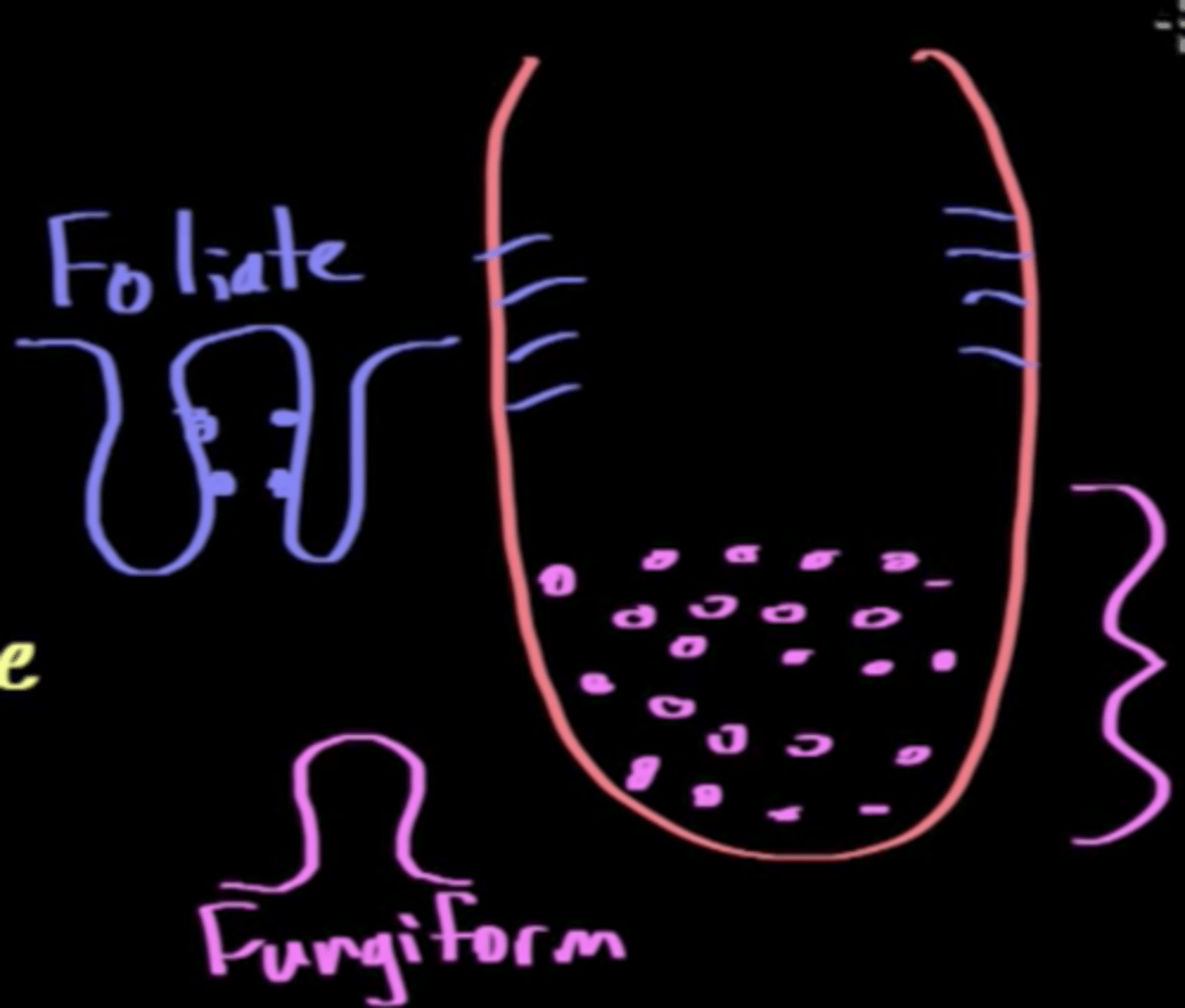
______________ taste buds are flat mound structures that are primarily found in posterior portion of the tongue.
(A) Fungiform
(B) Foliate
(C) Circumvallate
(D) Filiform
(C) Circumvallate
Circumvallate taste buds flat mound structures that are primarily found in posterior portion of the tongue.
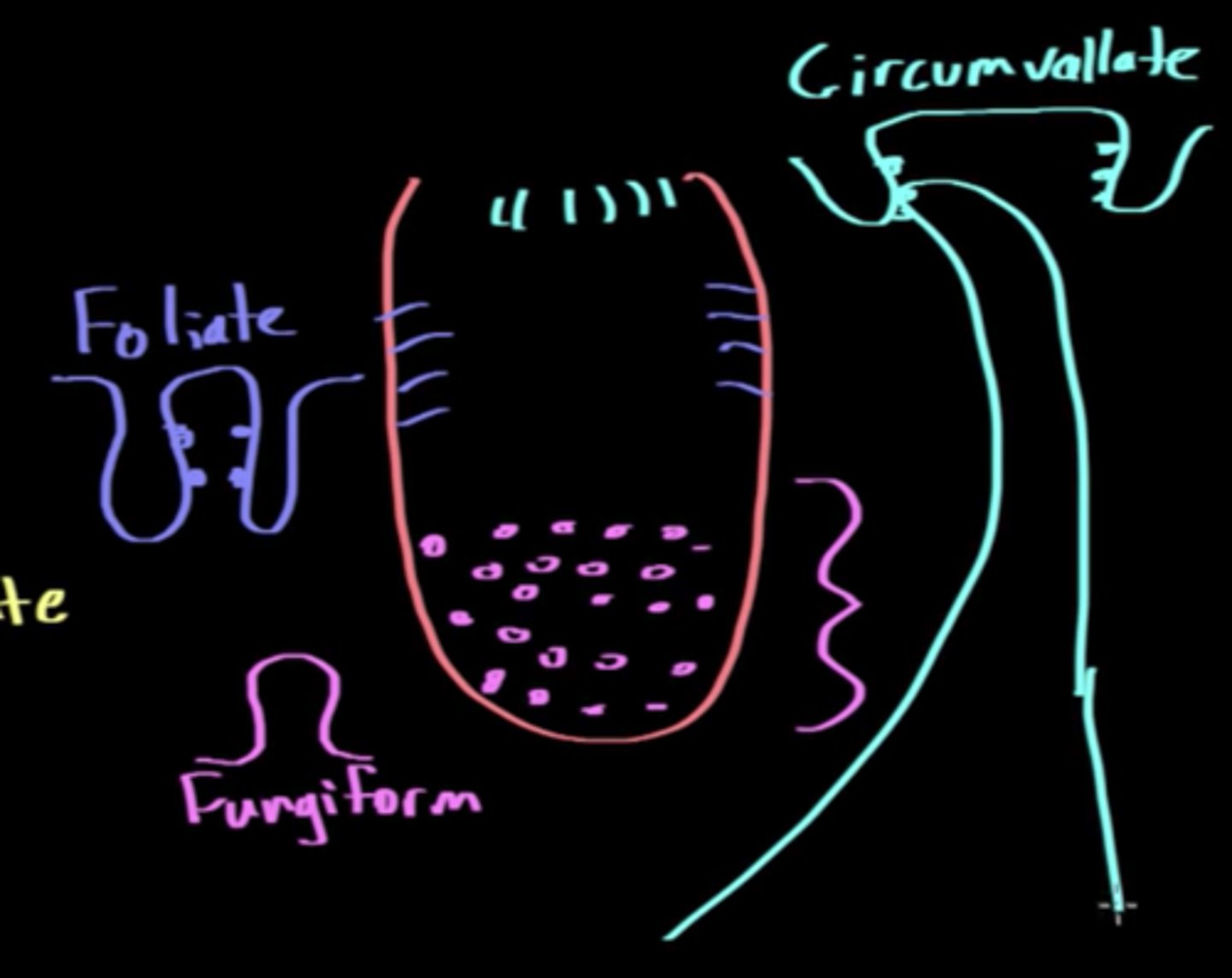
How are the 5 different tastes (salty, sweet, sour, umami, and bitter) sensed by the tongue?
(A) There are areas of the tongue whose taste buds are sensitive to one of the five flavors.
(B) There are areas of the tongue whose taste bud types are sensitive to one of the five flavors.
(C) Each taste bud is composed of multiple cells, that combine to sense the 5 flavors.
(D) Each taste bud is composed of multiple cells, that combine to sense 1 of the 5 flavors.
(C) Each taste bud is composed of multiple cells, that combine to sense the 5 flavors.
Each taste bud is composed of multiple cells, that combine to sense the 5 flavors. Because of this, any flavor can be tasted on any part of the tongue!
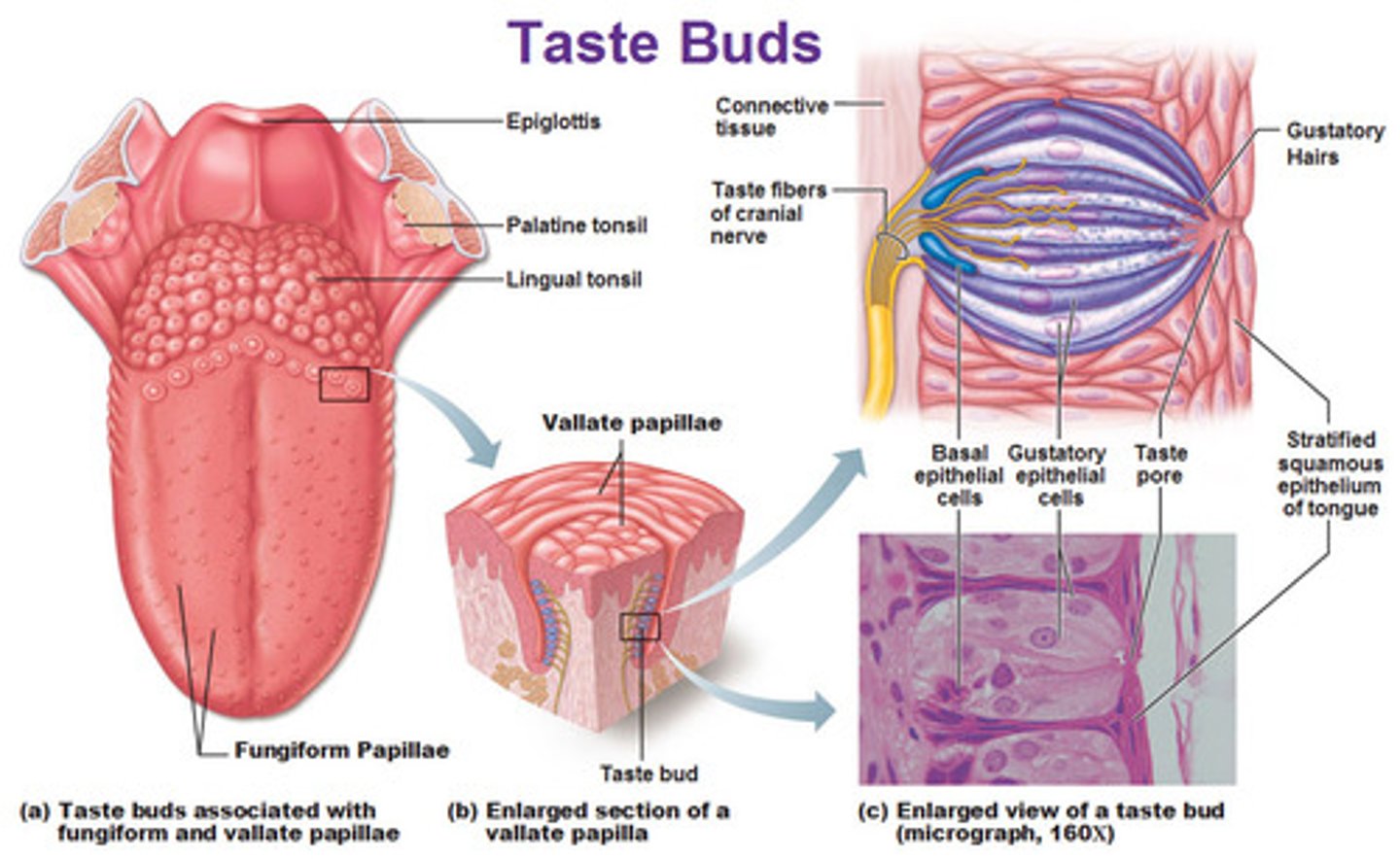
Considering the proximity of the receptors for different flavors. How does the Labelled Lines Model account for the 5 flavors not mixing?
The Labelled lines model says that each axon in a tastebud is separated by cell type, and different cell types' axons never converge or mix.

Which taste cells rely on G-Protein Coupled Receptors?
(A) Sweet, Salty, Sour
(B) Sweet, Umami, Bitter
(C) Salty, Sour, Umami
(D) Bitter, Umami, Sour
(B) Sweet, Umami, Bitter
Sweet, Umami, and Bitter taste cells rely on G-Protein Coupled Receptors.
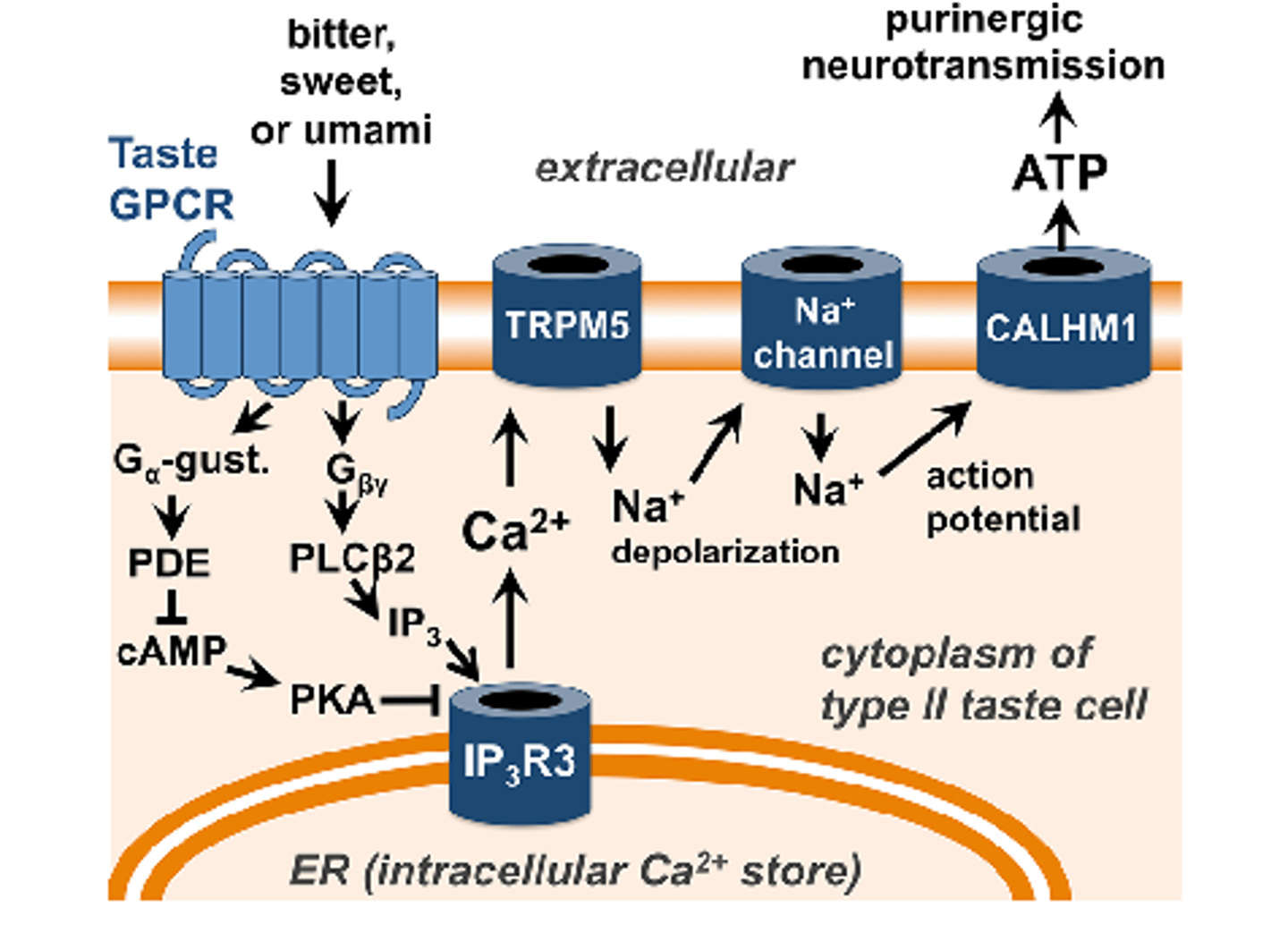
Which taste cells rely on Ion Channels?
(A) Salty, Sour
(B) Bitter, Sweet
(C) Sweet, Umami
(D) Bitter, Umami
(A) Salty, Sour
Salty and Sour taste cells rely on Ion Channels.
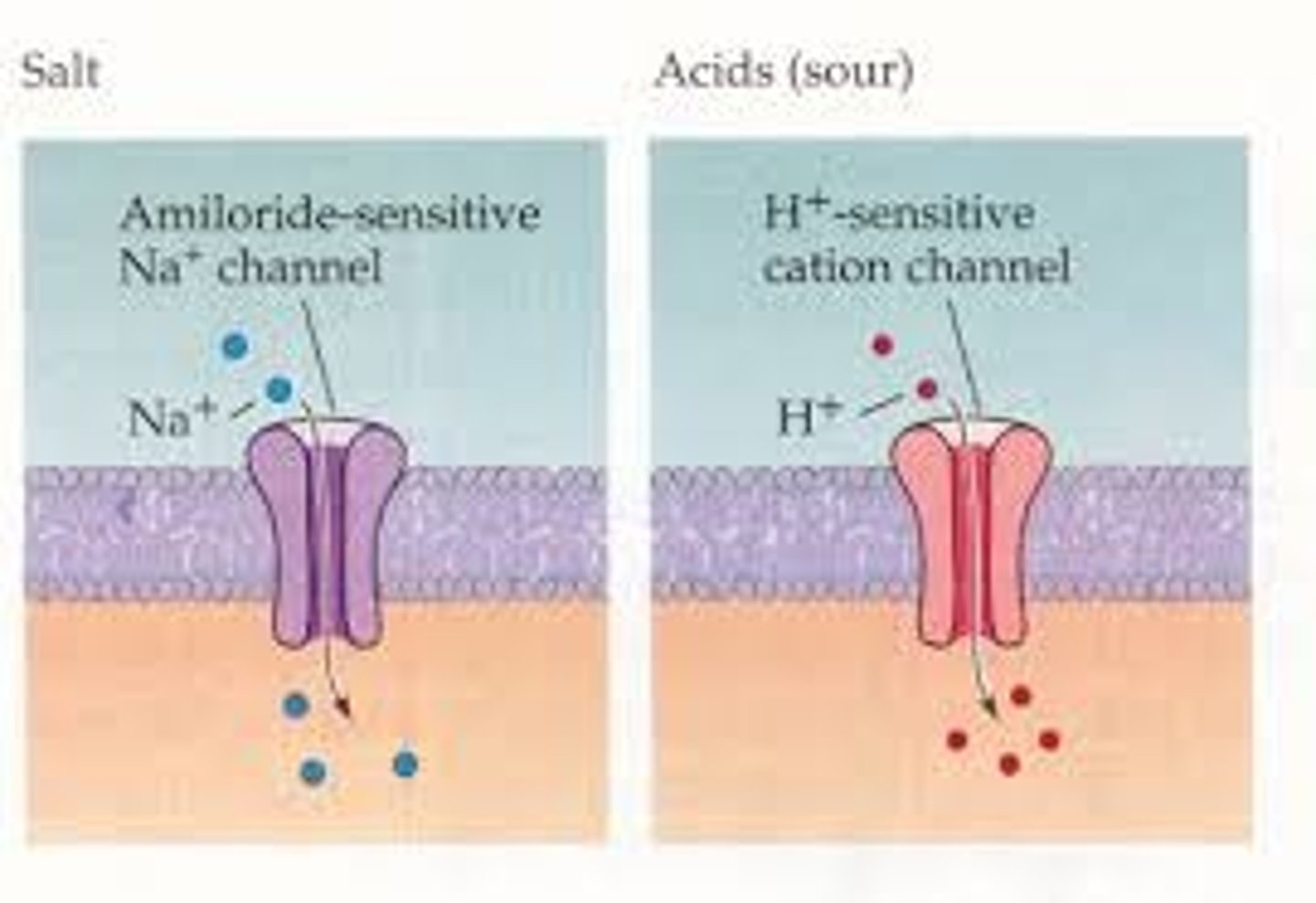
Compare and Contrast the function of G-Protein Coupled receptors and Ion Channels in terms of the Gustatory System?
GPCR: A sweet, umami or bitter molecule binds a GPCR which causes a conformational change. The G-protein then dissociates which opens an ion channel and thus causes the cell to depolarize and fire an Action Potential.
Ion Channel: A sour or salty molecule binds to a receptor on an Ion channel which opens causing the cell to depolarize and fire an Action Potential
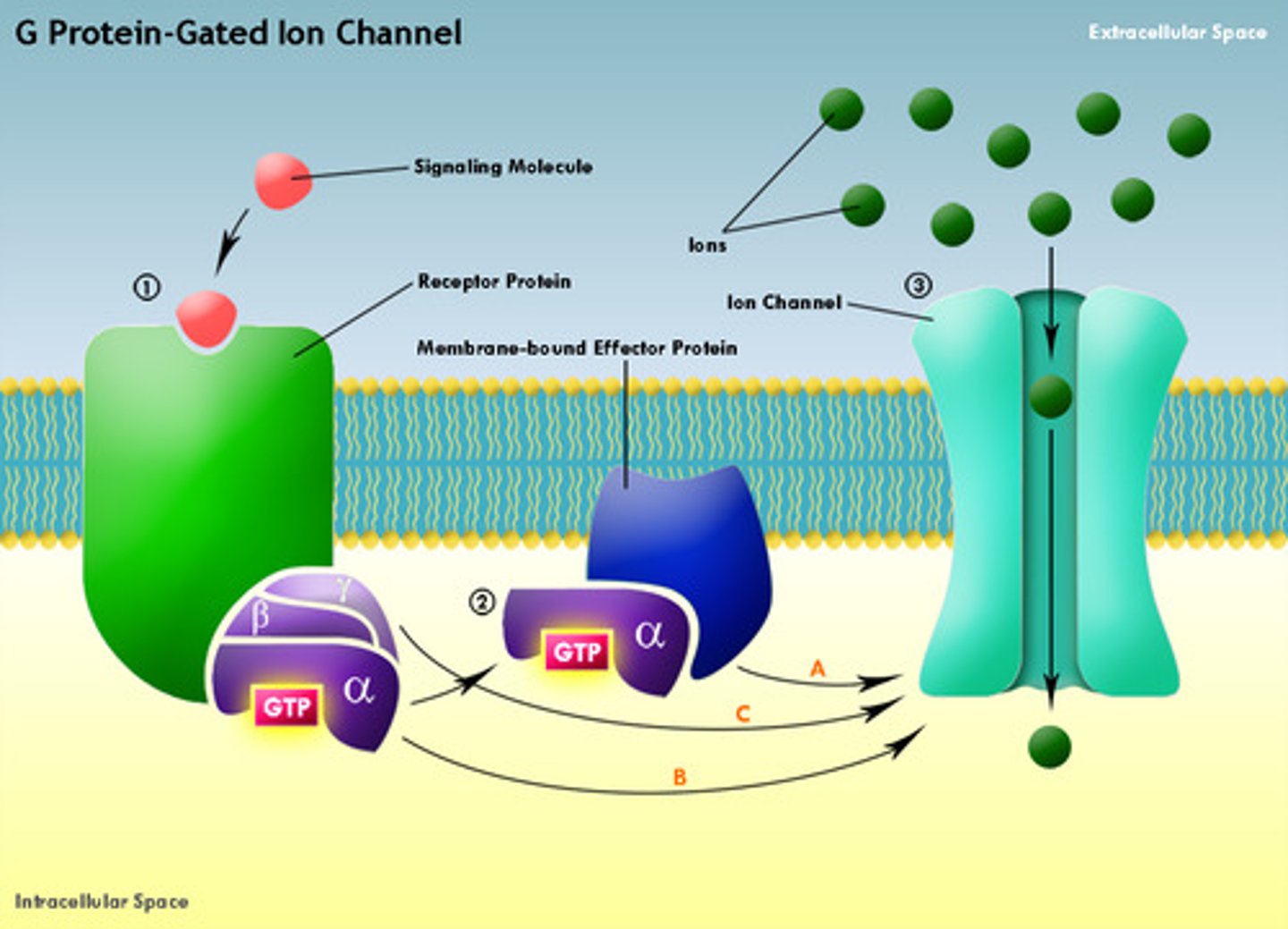
When an Ion channel opens due to receptor binding, do cations or anions flow into the cell, causing depolarization?
Cations. When a molecule binds to a receptor on an ion channel, the ion channel opens and +ions begin to flow in, causing depolarization, and an action potential.
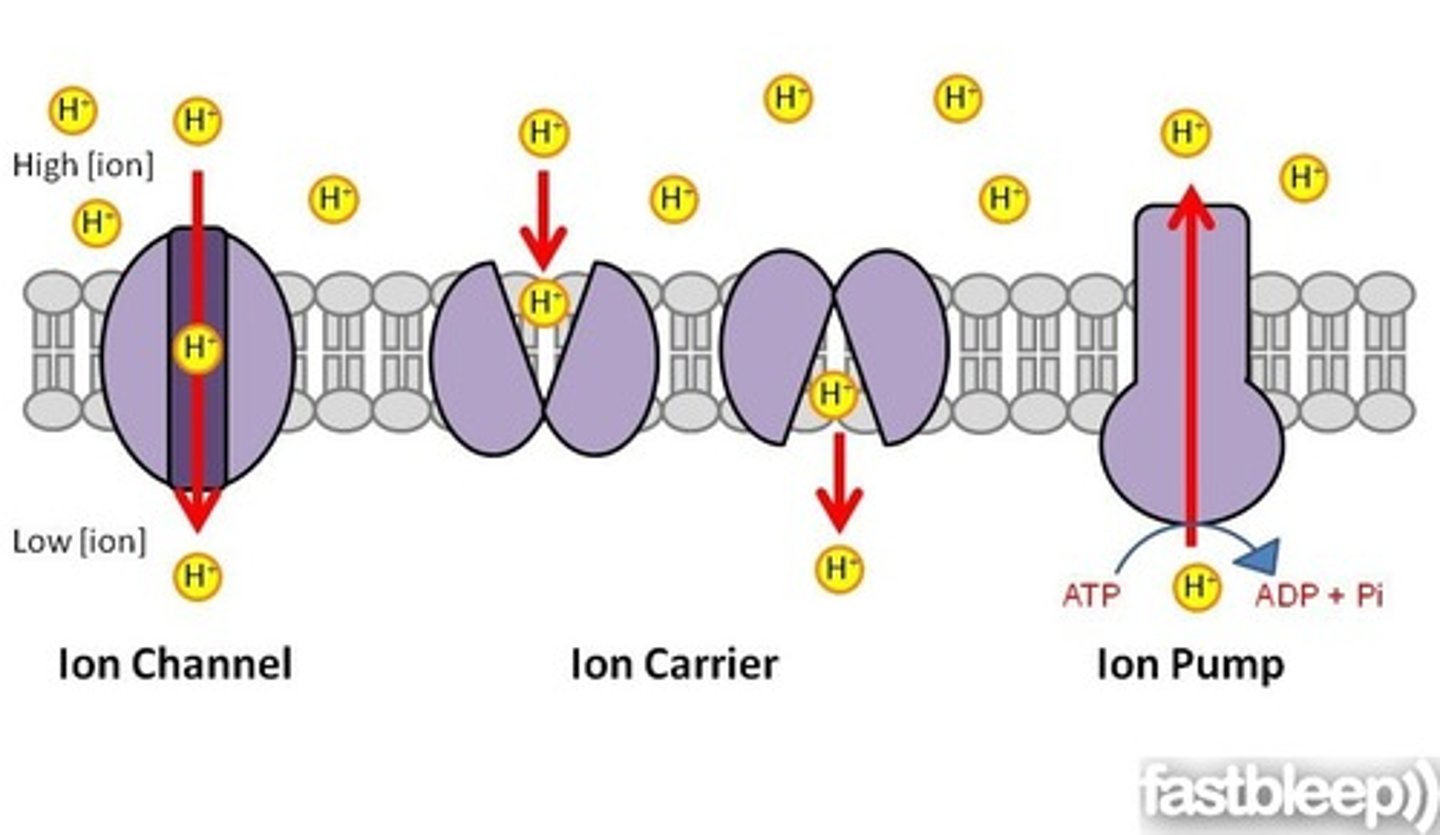
If a salt receptor was accidentally expressed and activated in a sweet cell, would the sensed taste in the brain be salty or sweet? Why?
Sweet. Because of the Labelled Lines Model, the type of cell activated will determine the sensed taste, not the receptor activated.

What is referred to as the awareness of our self and the surrounding environment?
(A) Consciousness
(B) Daydreaming
(C) Drowsiness
(D) Sleep
(A) Consciousness
Consciousness is referred to as the awareness of our self and the surrounding environment.

CRB One of the most well-known information processing models for human minds is the Dual-Coding Theory. Which of the following are the two manners in which information is proposed to be processed and stored?
(A) Images and Feelings
(B) Images and Verbal Associations
(C) Feelings and Verbal Associations
(D) Feelings and Thoughts
(B) Images and Verbal Associations
Paivio's Dual-Coding Theory suggests that both verbal association and visual images are used for processing and storing information.

CRB Which of the following is NOT one of the four pillars of Information Processing Model
(A) Thinking requires sensation, encoding and storage of stimuli.
(B) Stimuli must be analyzed by the spinal cord or brain to be useful in decision-making.
(C) Decisions from one context can be later used and adjusted to be applied to new problems.
(D) Problem solving depends on both the complexity of the problem and the person's cognitive level.
(B) Stimuli must be analyzed by the spinal cord or brain to be useful in decision-making.
For information to be useful for decision-making, it must be analyzed by the brain. "Analysis" at the spinal cord would be an automatic response.
Match the following states of consciousness with their key characteristics
(1) Alert
(2) Daydreaming
(3) Drowsy
(4) Sleep
(A) Seemingly purposeless flow of thoughts come to mind
(B) Essentially unconscious, little awareness of world
(C) Almost asleep, but semi-aware of the world
(D) Awake and able to think
(1) Alert -> (D) Awake and able to think
(2) Daydreaming -> (A) Seemingly purposeless flow of thoughts come to mind
(3) Drowsy -> (C) Almost asleep, but semi-aware of the world
(4) Sleep -> (B) Essentially unconscious, little awareness of world
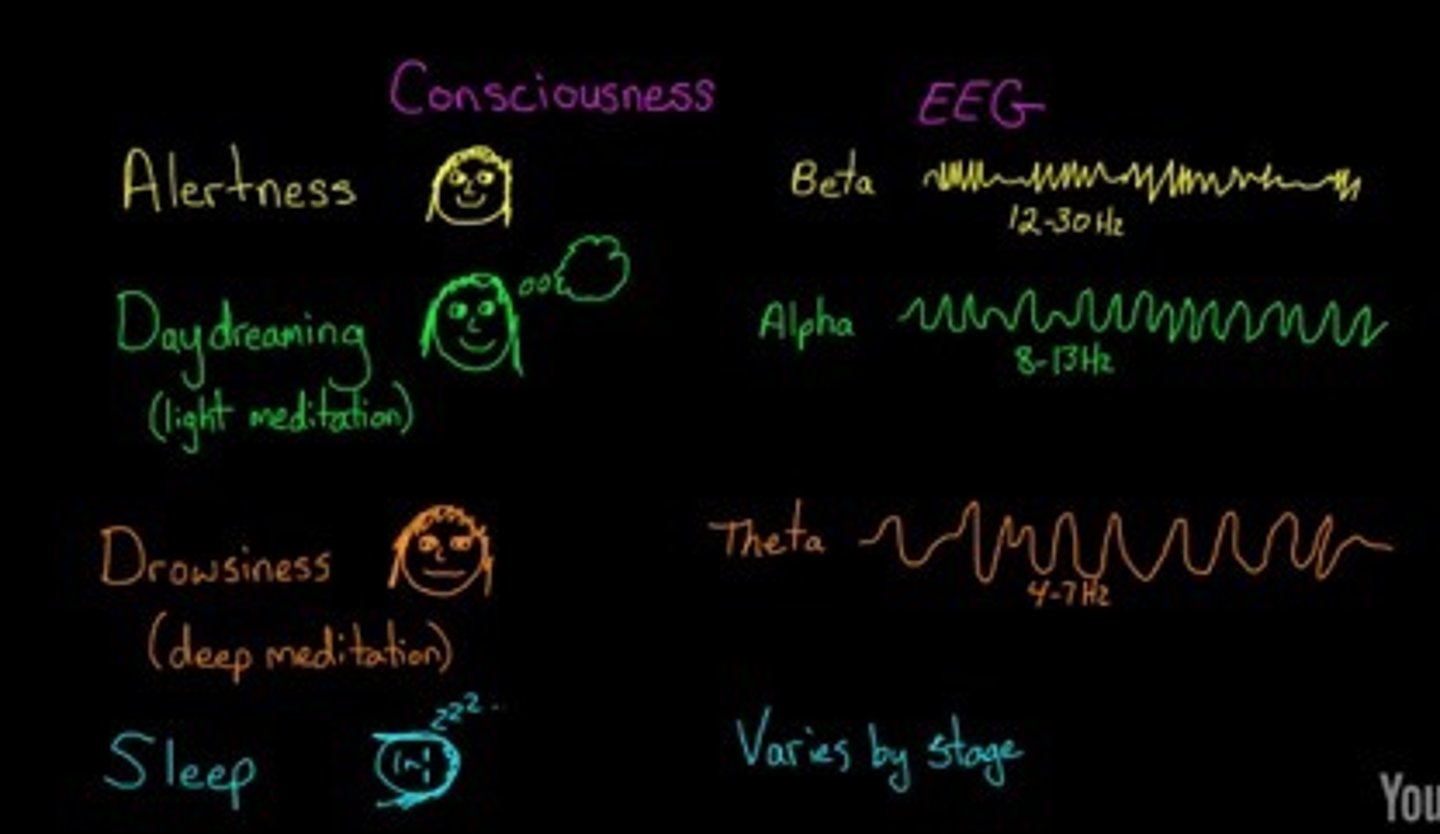
CRB Alertness would be maintained by the prefrontal cortex's interactions with what other brain structure?
(A) Cerebellum
(B) Substantia Nigra
(C) Nucleus Accumbens
(D) Reticular Formation
(D) Reticular Formation
The Reticular Formation is in the brainstem and keeps the cortex awake and alert.
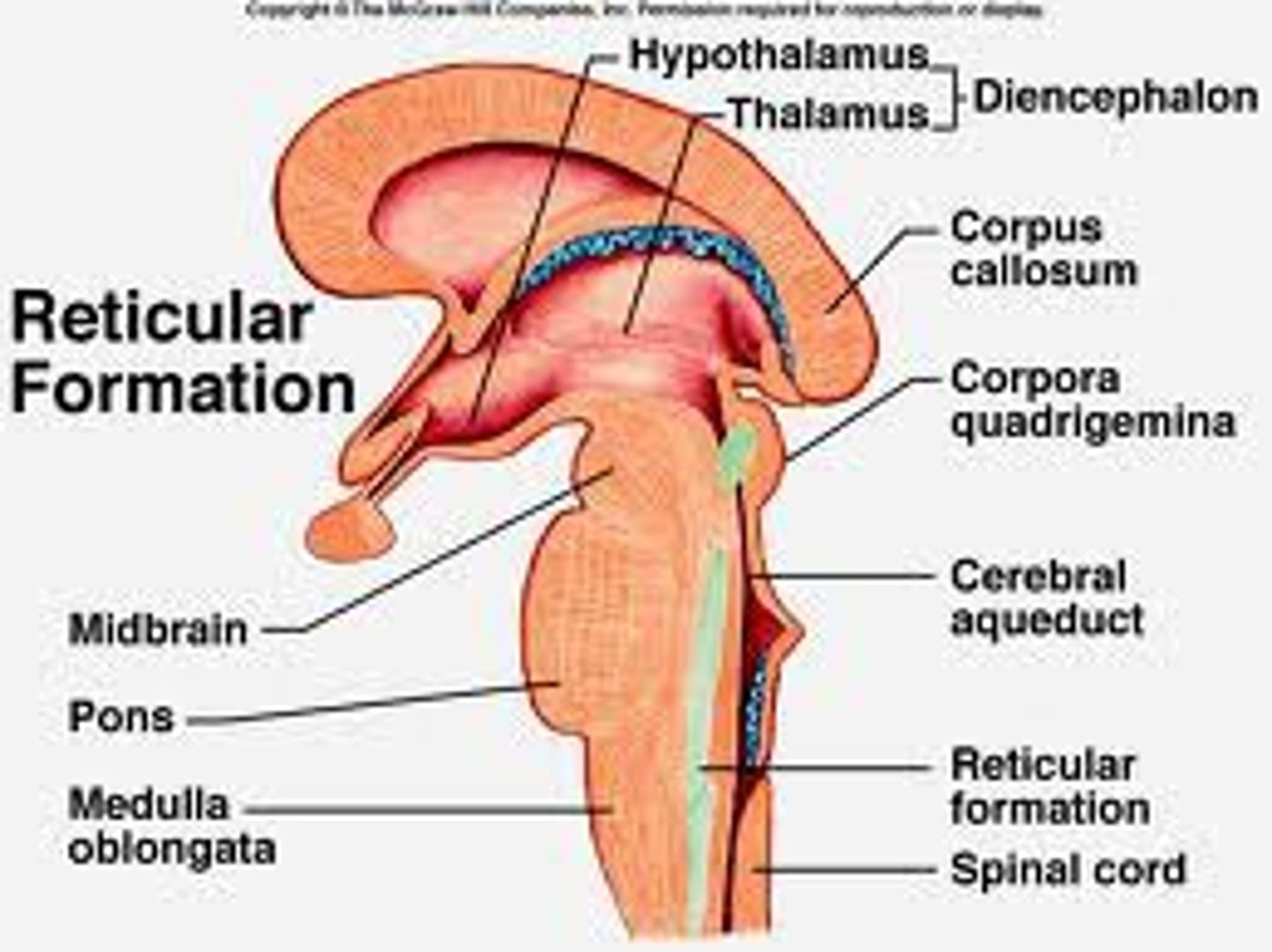
On an electroencephalogram (EEG), _________ waves have the highest frequency (12-30 Hz) and are are seen when alert. __________ waves are closer to 4-7 Hz are seen most often in drowsiness, early sleep, and especially in children.
(A) Alpha waves, Delta waves
(B) Beta waves, Theta waves
(C) Delta waves, Alpha waves
(D) Theta waves, Beta waves
(B) Beta waves, Theta waves
On an electroencephalogram (EEG), BETA waves have the highest frequency (12-30 Hz) and are are seen when alert. THETA waves are closer to 4-7 Hz are seen most often in drowsiness, early sleep, and especially in children.

CRB True or false? Alpha waves are more synchronized than Beta waves.
True. Alpha waves are more synchronized than Beta waves.
On an electroencephalogram (EEG), ___________ waves have a frequency of 8-13 Hz and are present when one is in a daydreaming state, while ___________ waves have a frequency of 0.5-3 Hz and are seen most often when one is in a coma or deep sleep.
(A) Beta waves, Delta Waves
(B) Alpha waves, Delta Waves
(C) Beta waves, Theta Waves
(D) Alpha waves, Theta Waves
(B) Alpha Waves, Delta Waves
On an electroencephalogram (EEG), ALPHA waves have a frequency of 8-13 Hz and are present when one is in a daydreaming state, while DELTA waves have a frequency of 0.5-3 Hz and are seen most often when one is in a coma or deep sleep.
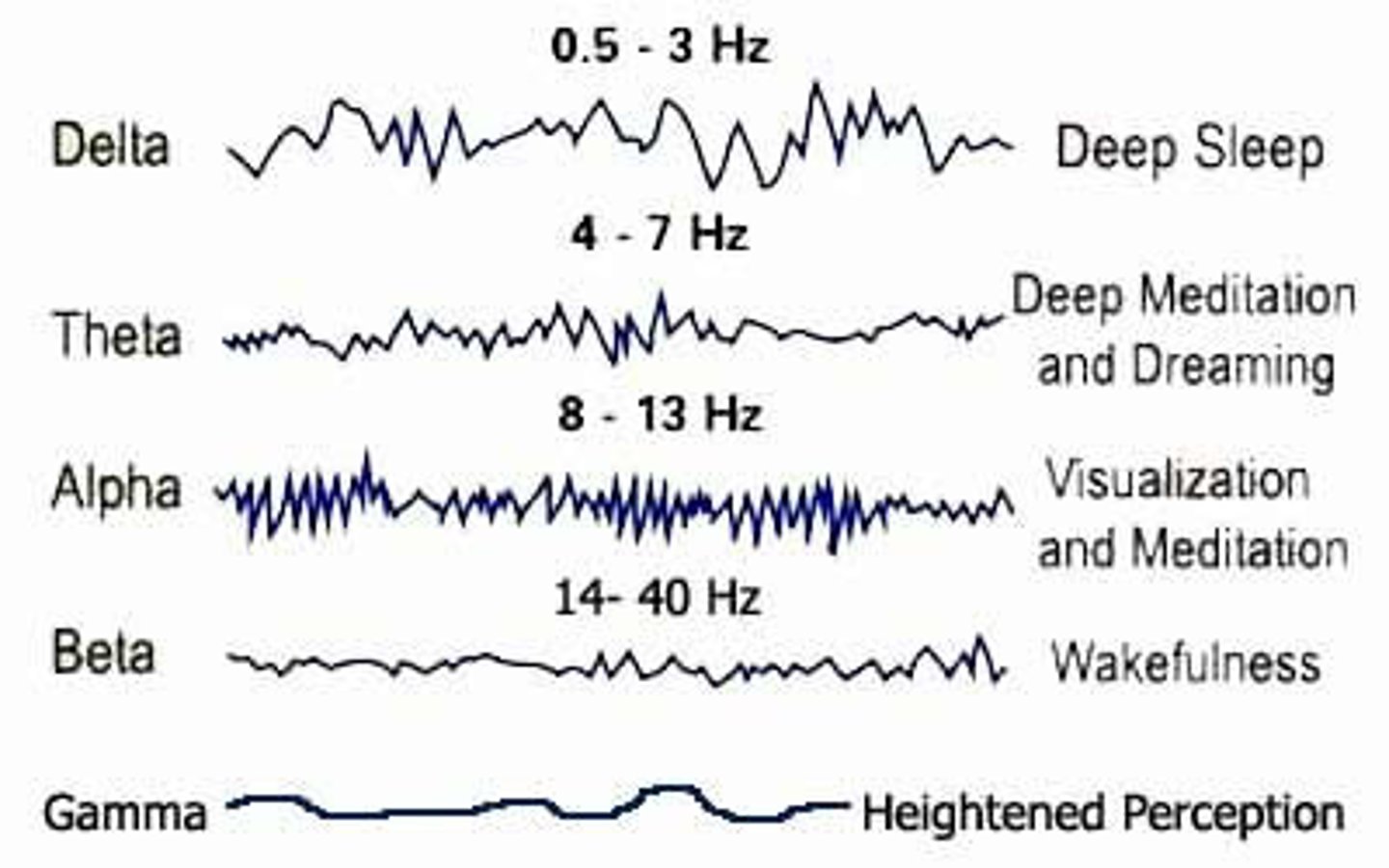
A Human's brain goes through 4 main stages during sleep. These stages occur in __________ minute cycles during a normal night of sleep.
(A) 70
(B) 80
(C) 90
(D) 100
(C) 90
A Human's brain goes through 4 main stages during sleep. These stages occur in 90 minute cycles during a normal night of sleep.

Of the 4 main stages of sleep, which stages are characterized as Non-Rapid Eye Movement (non-REM)?
The first 3 stages: N1, N2, and N3.

Which sleep stage is between sleep and wakefulness? This stage of sleep produces Theta Waves, and one may experience hypnagonic hallucinations (imagining things that are not there), or hypnic jerks (feeling of falling).
(A) N1
(B) N2
(C) N3
(D) REM
(A) N1
N1 is the sleep stage between sleep and wakefulness. This stage of sleep produces Theta Waves, and one may experience hypnagonic hallucinations (imagining things that are not there), or hypnic jerks (feeling of falling).

Which stage of sleep is characterized by Theta Waves, Sleep Spindles, and K-Complexes?
(A) N1
(B) N2
(C) N3
(D) REM
(B) N2
N2 is a sleep stage that is characterized by Theta Waves, Sleep Spindles and K-Complexes.
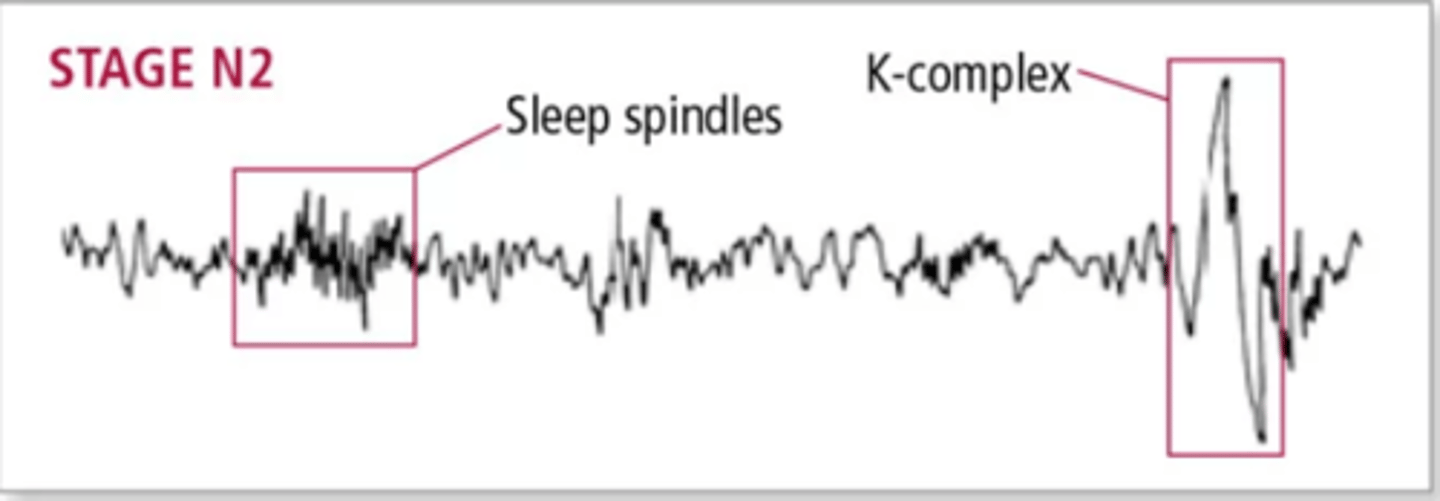
What refers to a burst of rapid brain activity during sleep, that some researchers believe help inhibit certain perceptions so that one can maintain a tranquil state during sleep? Ex: Associated with the ability to sleep through loud noises.
(A) K-Complexes
(B) non-REM sleep
(C) REM sleep
(D) Sleep spindles
(D) Sleep spindles
Sleep spindles refer to a burst of rapid brain activity during sleep, that some researchers believe help inhibit certain perceptions so that one can maintain a tranquil state during sleep
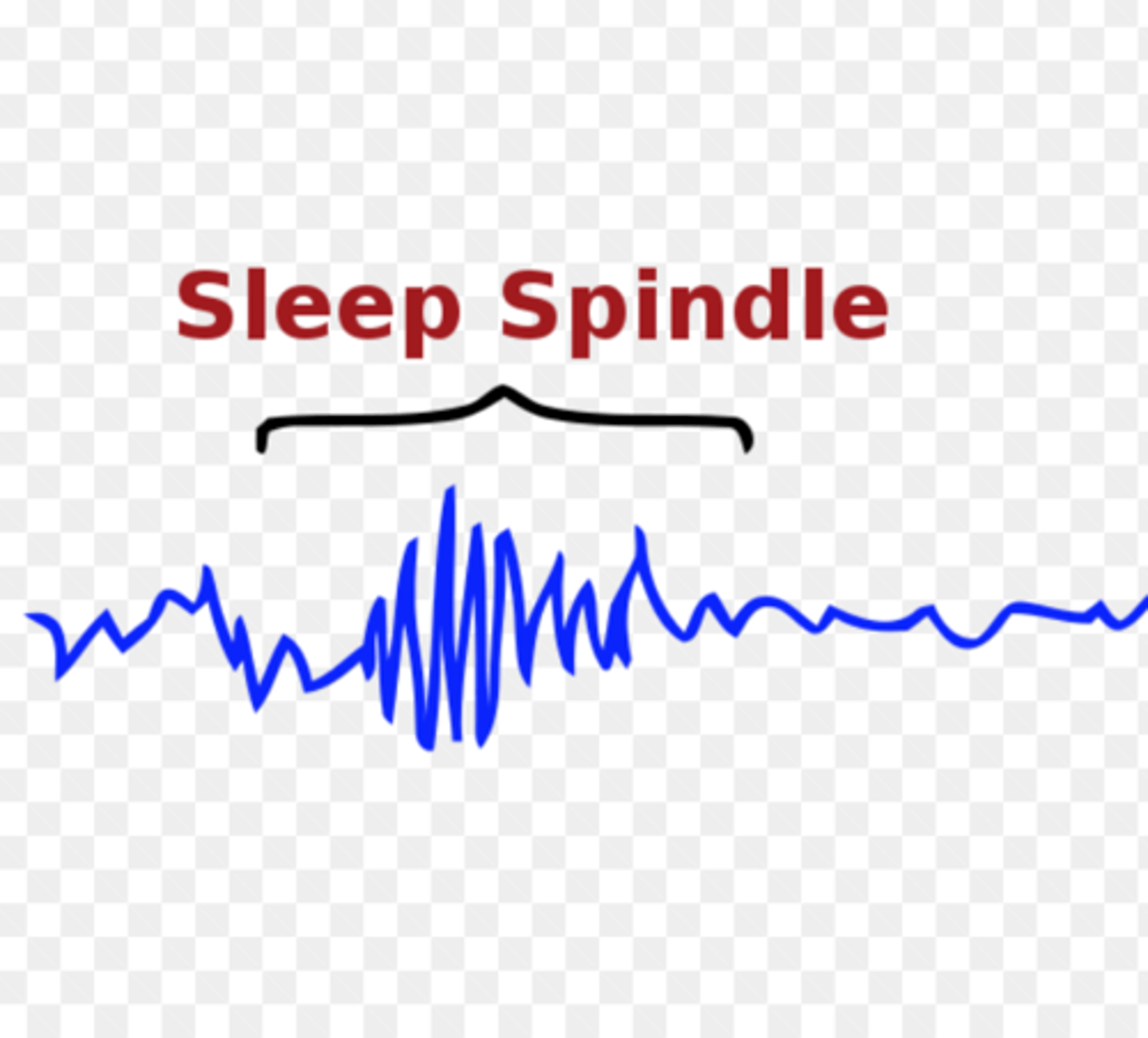
What refers to a type of brain activity that suppresses cortical arousal, while also helping sleep based memory formation? This type of activity can occur naturally or by gently touching someone while they are sleeping.
(A) K-Complexes
(B) non-REM sleep
(C) REM sleep
(D) Sleep spindles
(A) K-Complexes
K-Complexes refer to a type of brain activity that suppresses cortical arousal, while also helping sleep based memory formation.
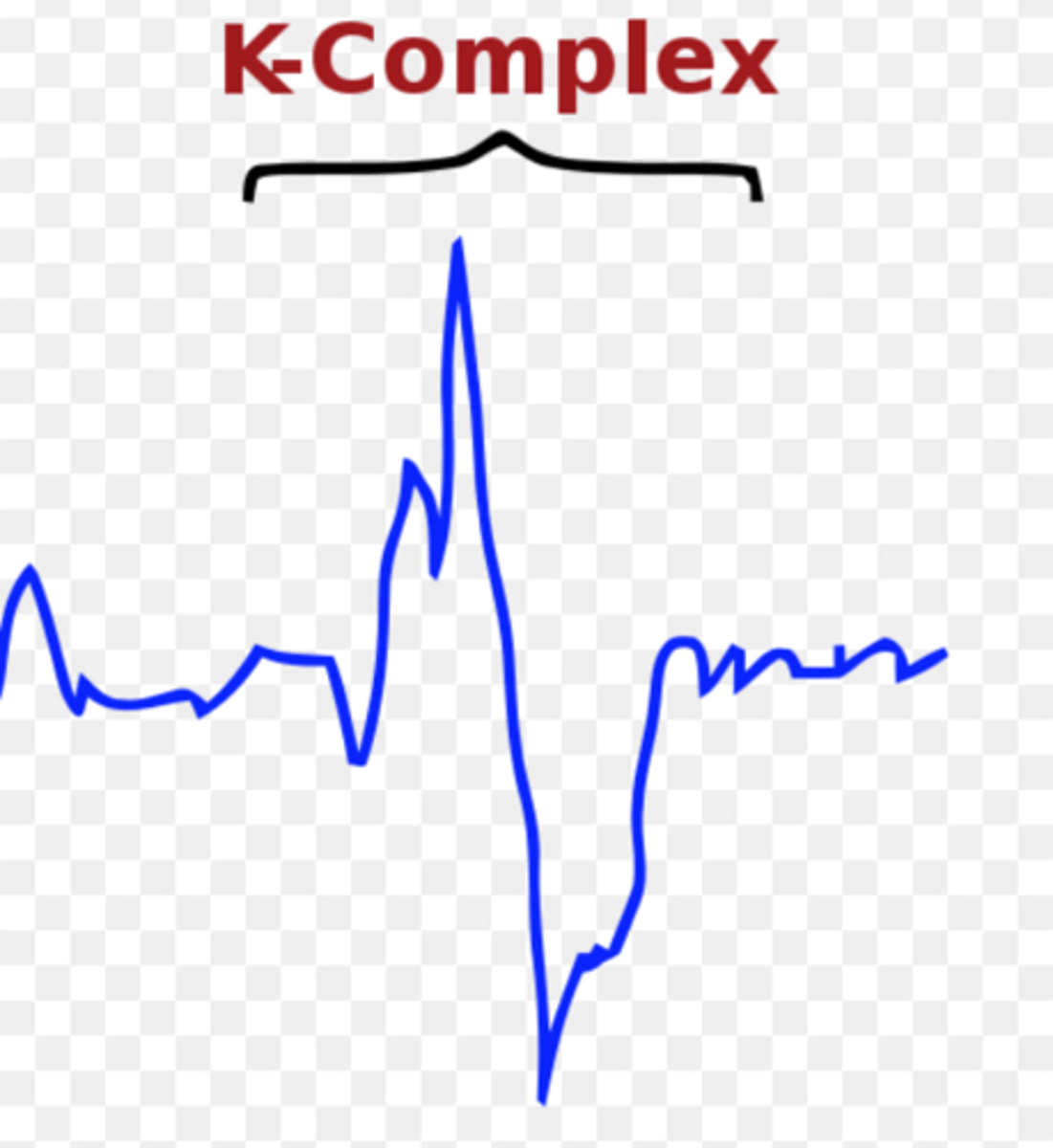
Which stage of sleep is characterized as slow wave sleep and delta waves become present on an EEG? It is often very difficult to wake people up from this stage of sleep.
(A) N1
(B) N2
(C) N3
(D) REM
(C) N3
N3 is a stage of sleep that is characterized by slow wave sleep and delta waves become present on an EEG.
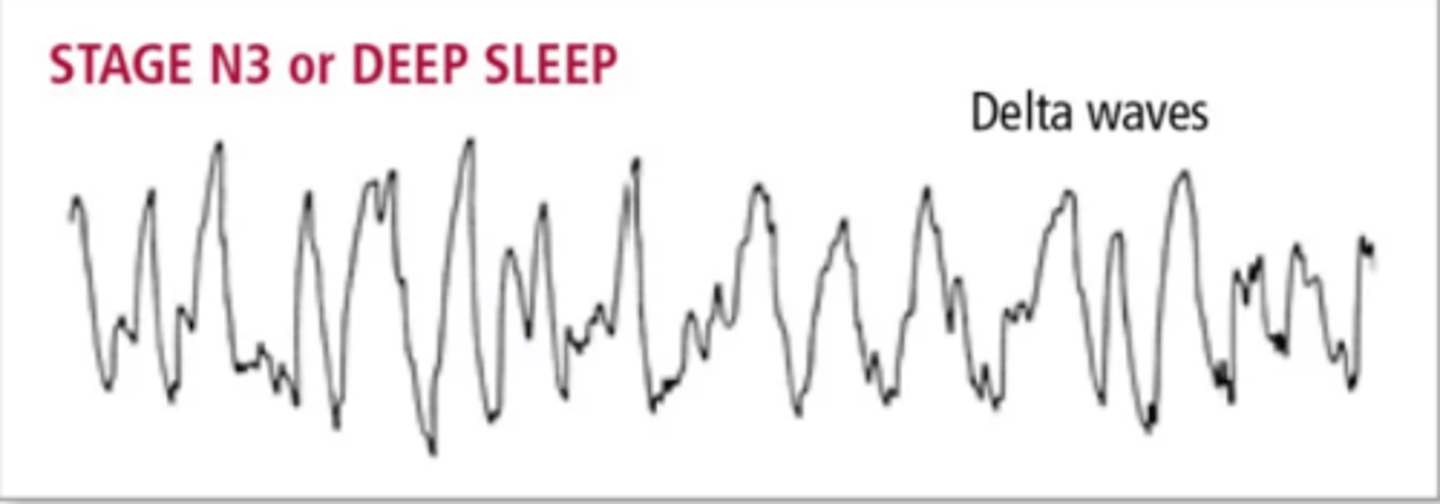
Which stage of sleep is characterized by rapid eye movement, however most of one's muscles are paralyzed? The most dreaming occurs in this stage of sleep and it is the most important stage of sleep for memory consolidation.
(A) N1
(B) N2
(C) N3
(D) REM
(D) REM
REM is a stage of sleep that is characterized by rapid eye movement, however most of one's muscles are paralyzed. The most dreaming occurs in this stage of sleep and it is the most important stage of sleep for memory consolidation.

In patients with insomnia, elevated cortisol levels are often found. This extra cortisol will __________ their metabolism and ___________ their relaxation and sleep.
(A) enhance, enhance
(B) enhance, suppress
(C) suppress, suppress
(D) suppress, enhance
(B) enhance, suppress
Cortisol is an "awake" or "stress" hormone that increases metabolism and stress, which will suppress relaxation and sleep
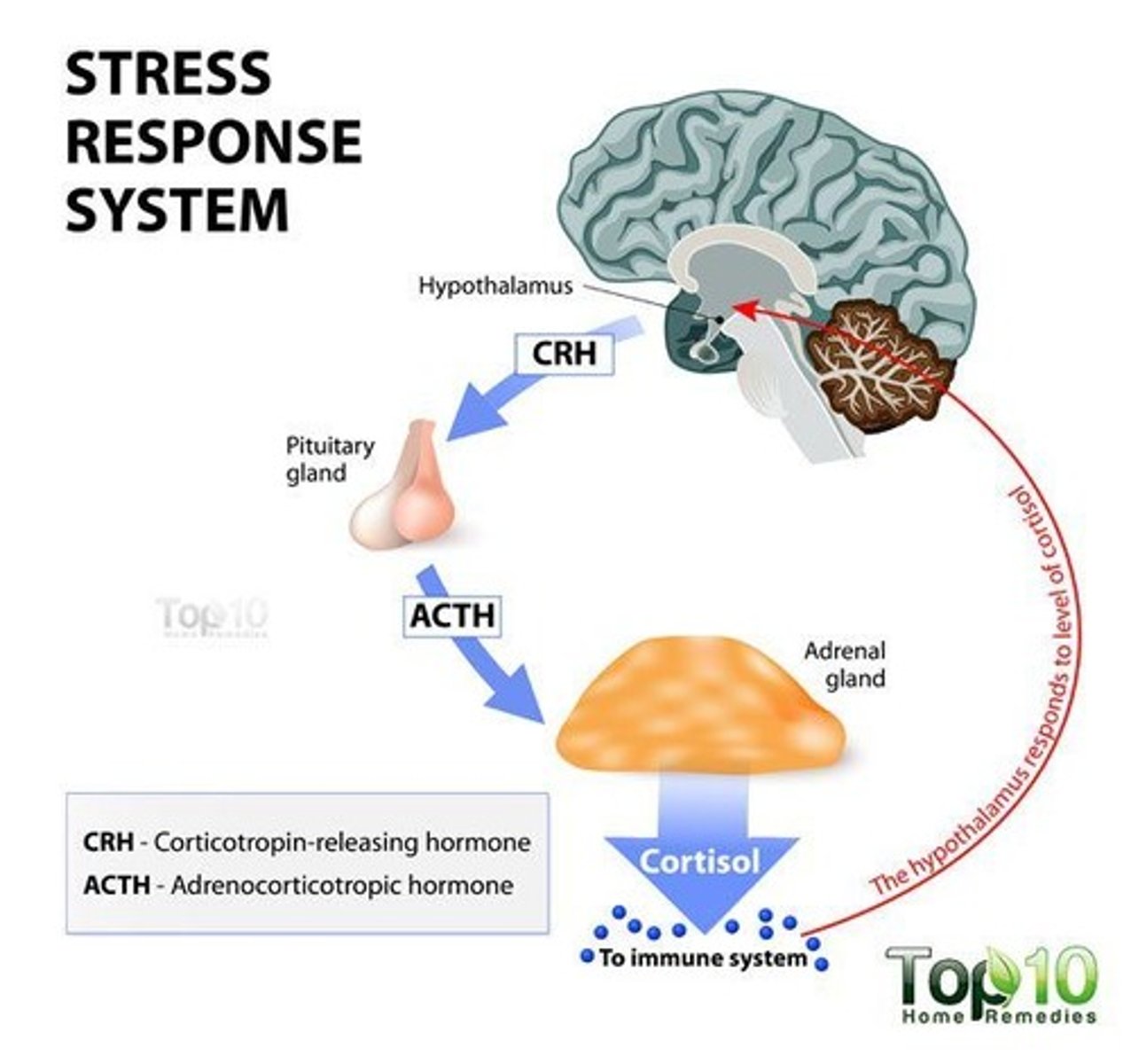
What is the usual order of sleep stages?
(A) N1->N2->N3->REM
(B) N1->N2->N3->N2->REM
(C) N1->N3->N2->REM
(D) N1->N2->N3->N2->N1->REM
(B) N1->N2->N3->N2->REM
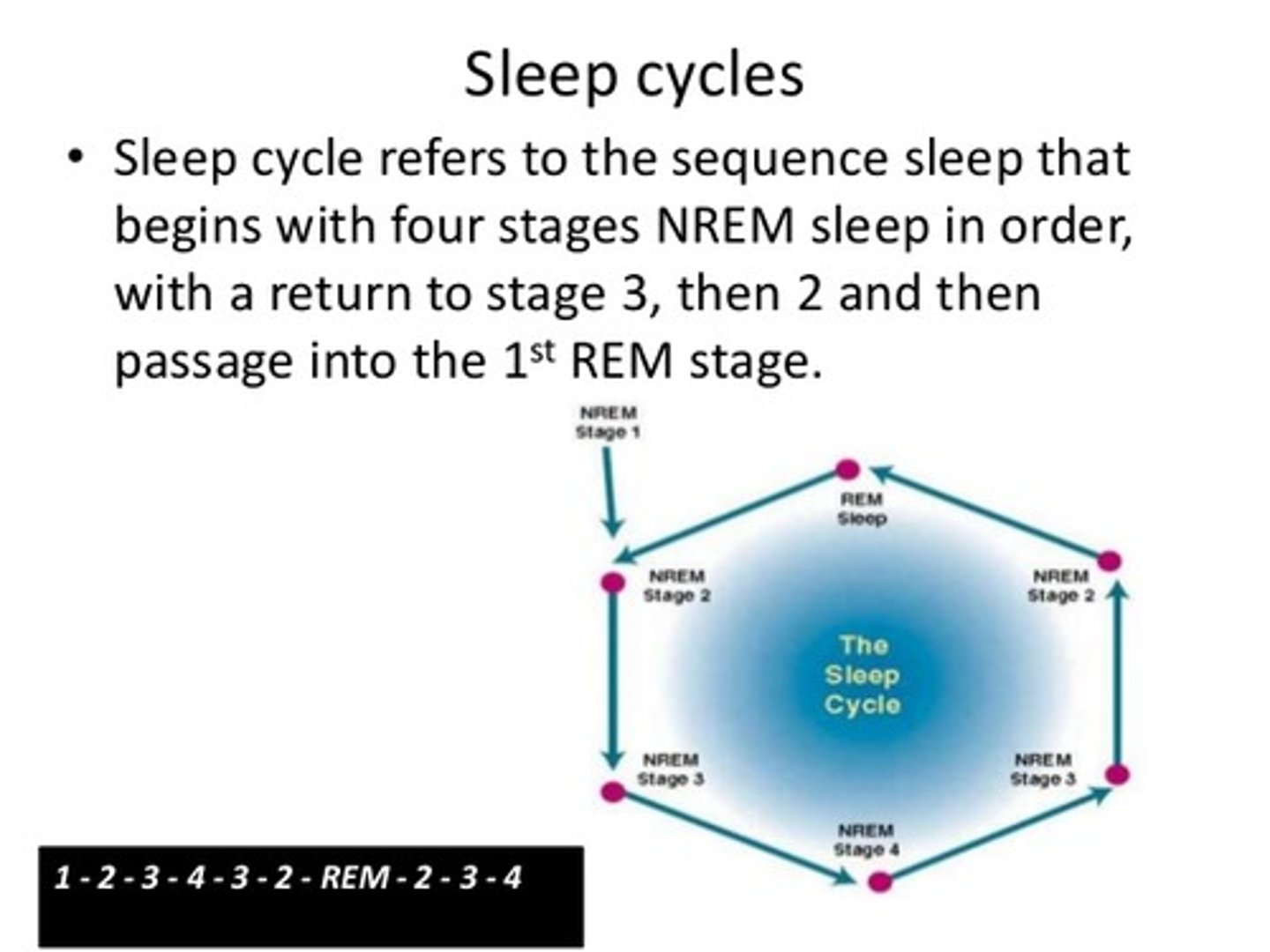
What refers to a human's internal biological clock that helps control a human's body temperature, sleep cycle and among other things?
(A) Intuition
(B) Habit
(C) Circadian Rhythm
(D) Hormones
(C) Circadian Rhythm
The Circadian Rhythm refers to a human's internal biological clock that helps control a human's body temperature, sleep cycle and among other things.
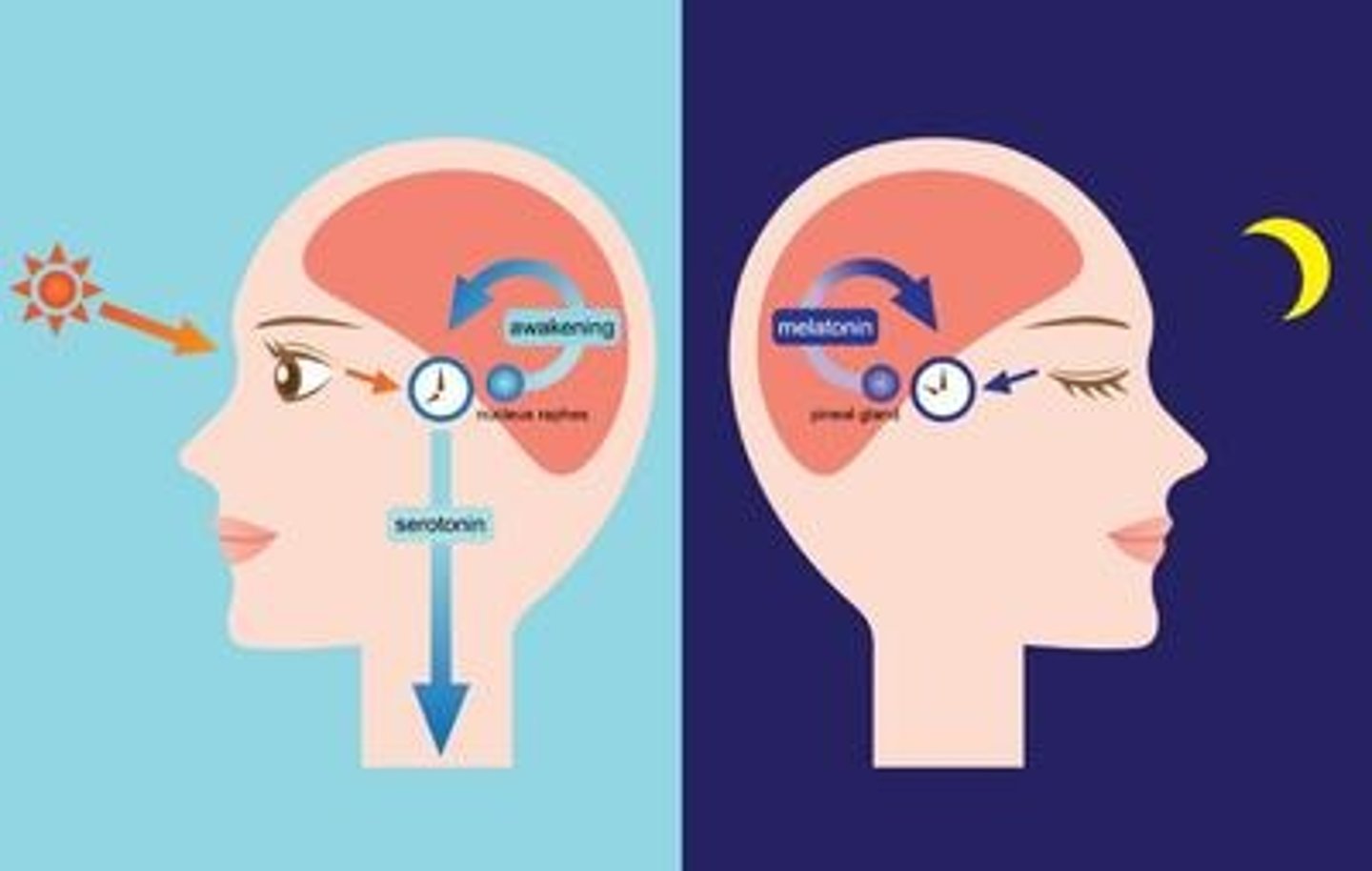
_____________ is a hormone, produced in the ___________ gland that helps control a human's internal clock or circadian rhythm.
(A) Aldosterone, Pineal
(B) Melatonin, Pineal
(C) Aldosterone, Adrenal
(D) Melatonin, Adrenal
(B) Melatonin, Pineal
Melatonin is a hormone, produced in the Pineal gland that helps control a human's internal clock or circadian rhythm.
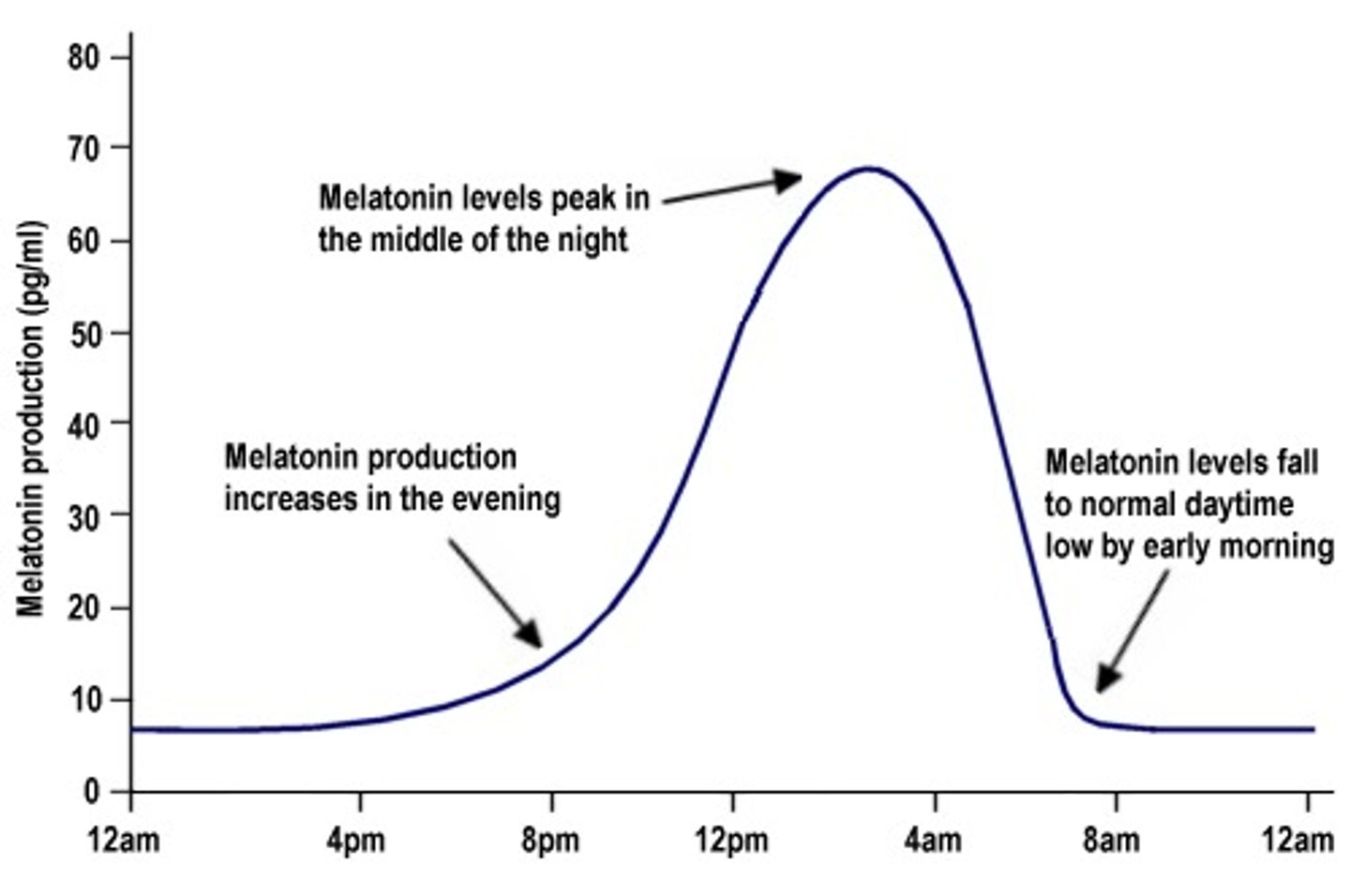
Why is REM sleep sometimes called paradoxical sleep?
REM sleep is sometimes referred to as paradoxical sleep because the brain is very active during this stage but the body is paralyzed and thus prevented from doing anything.

For patients with CRSD (Circadian Rhythm Sleep Disorders), daily rhythms like body temperature, alertness and hormone secretion are impaired. What is the circadian rhythm responsible for in a healthy individual?
The circadian rhythm is often called a "biological clock", because it causes sleepiness to gradually increase during the day, regulating sleep and wakefulness.

Why do we not realize how strange our dreams are when we are in REM sleep?
In REM sleep, the activity of the prefrontal cortex in the brain decreases. The prefrontal cortex is responsible for logical thinking, therefore our dreams in REM sleep can defy logic and not seem strange.
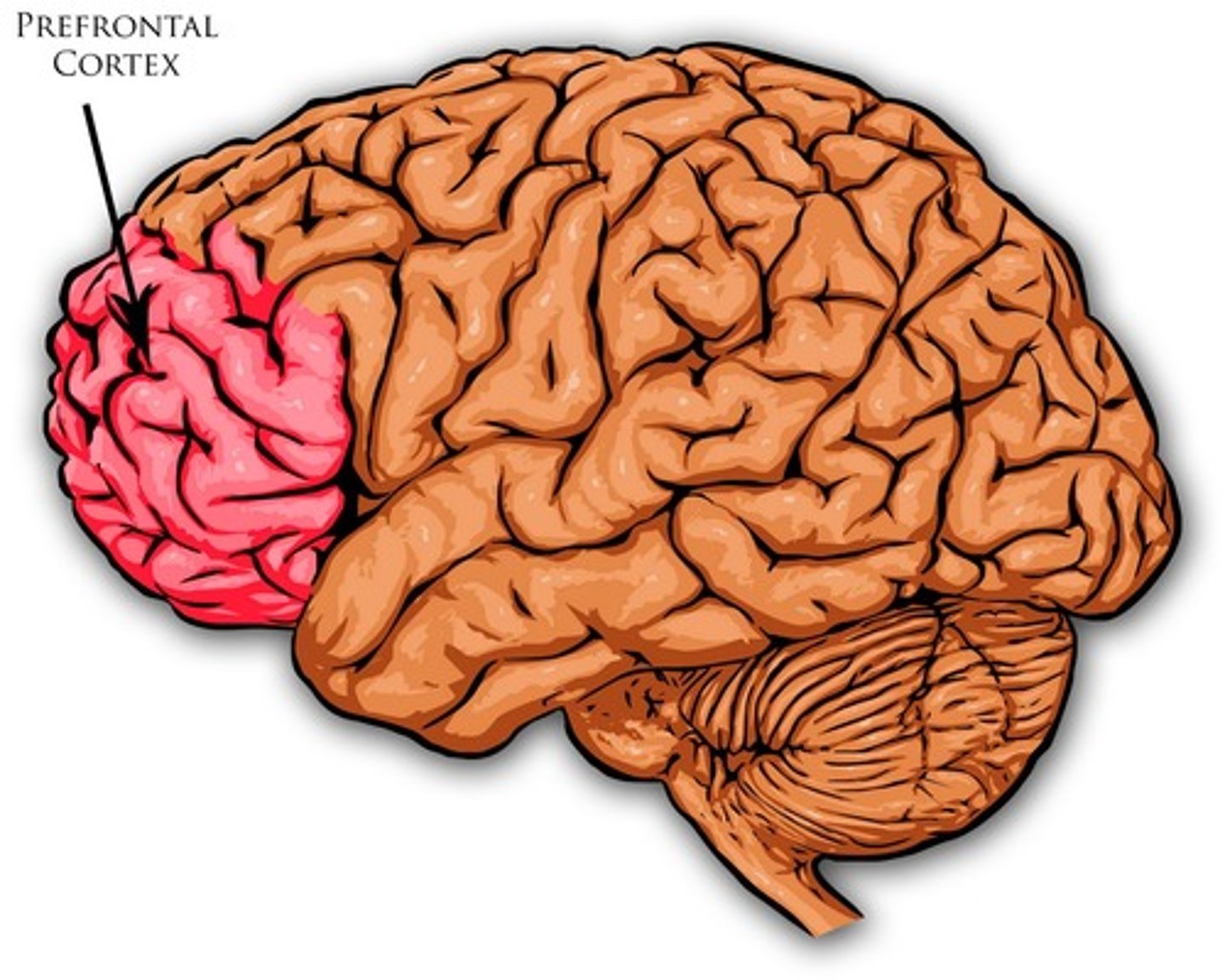
Which theory of dreaming explains that dreams are our unconscious thoughts and desires that need to be interpreted?
(A) Evolutionary Biology theory
(B) Sigmund Freud's Dream theory
(C) Memory Consolidation Theory
(D) Neural Pathway Theory
(B) Sigmund Freud's Dream Theory
Sigmund Freud's Dream Theory explains that dreams are our unconscious thoughts and desires that need to be interpreted.
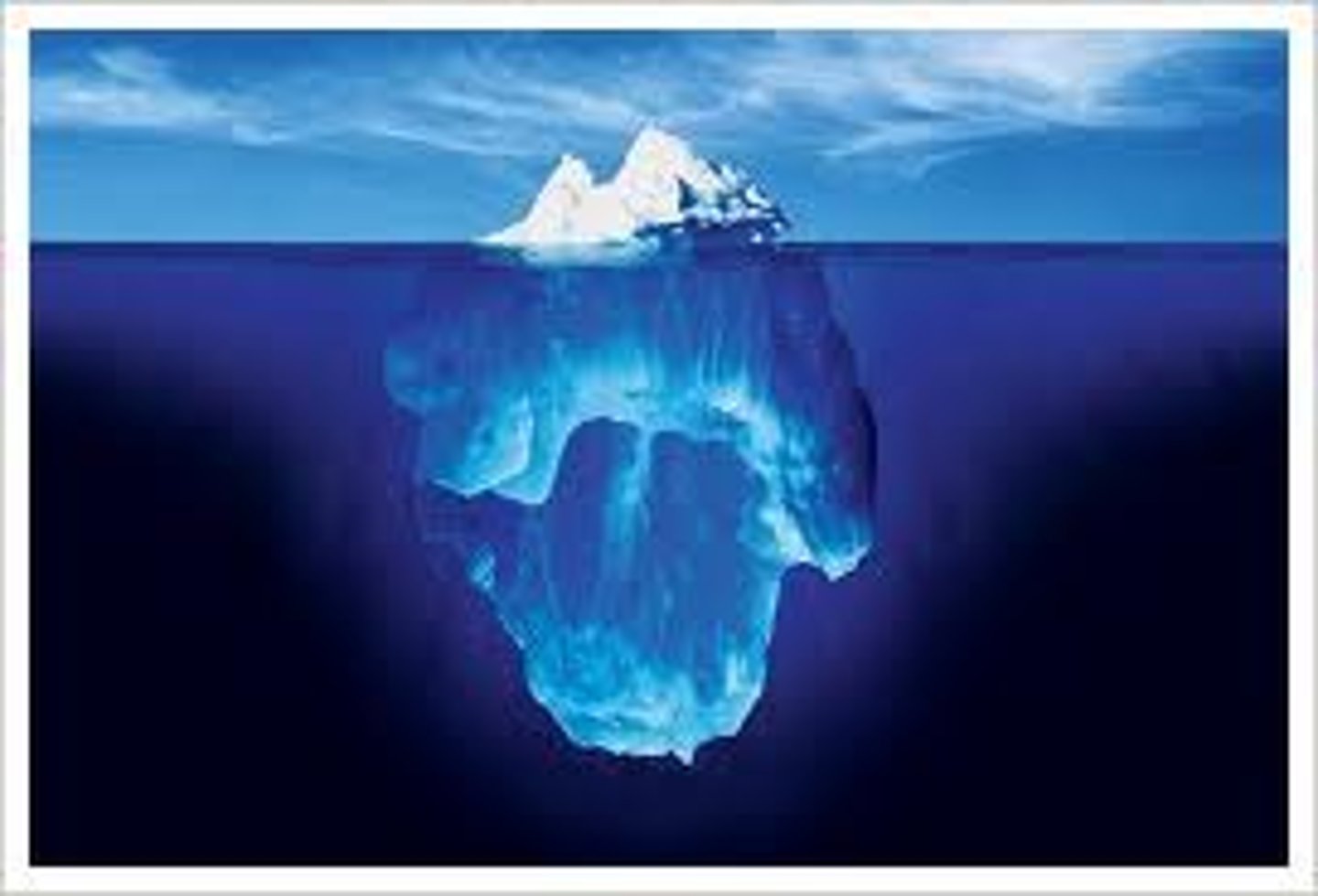
Which theory of dreaming explains that dreaming has developed to occur as a threat simulation to prepare for the real world, or as a method of problem solving?
(A) Evolutionary Biology theory
(B) Sigmund Freud's Dream theory
(C) Memory Consolidation Theory
(D) Neural Pathway Theory
(A) Evolutionary Biology theory
Evolutionary Biology theory explains that dreaming occurs as a threat simulation to prepare for the real world, or as a method of problem solving.
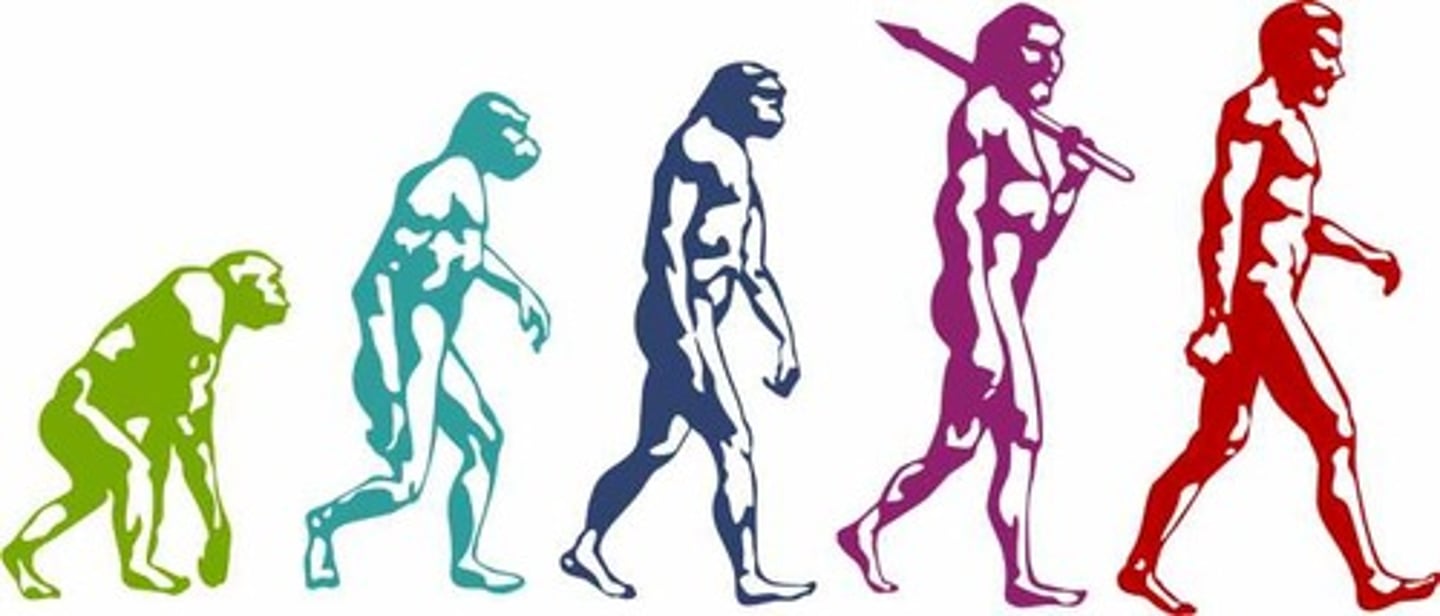
Freud's dream theory claims that dreaming is just the unconscious mind's work, and made of two parts. What is the difference between the manifest and latent content?
The manifest content can be considered the "plot".
Latent content is more interesting, because it is the hidden meaning behind manifest content, and analyzing this can help resolve hidden conflict.
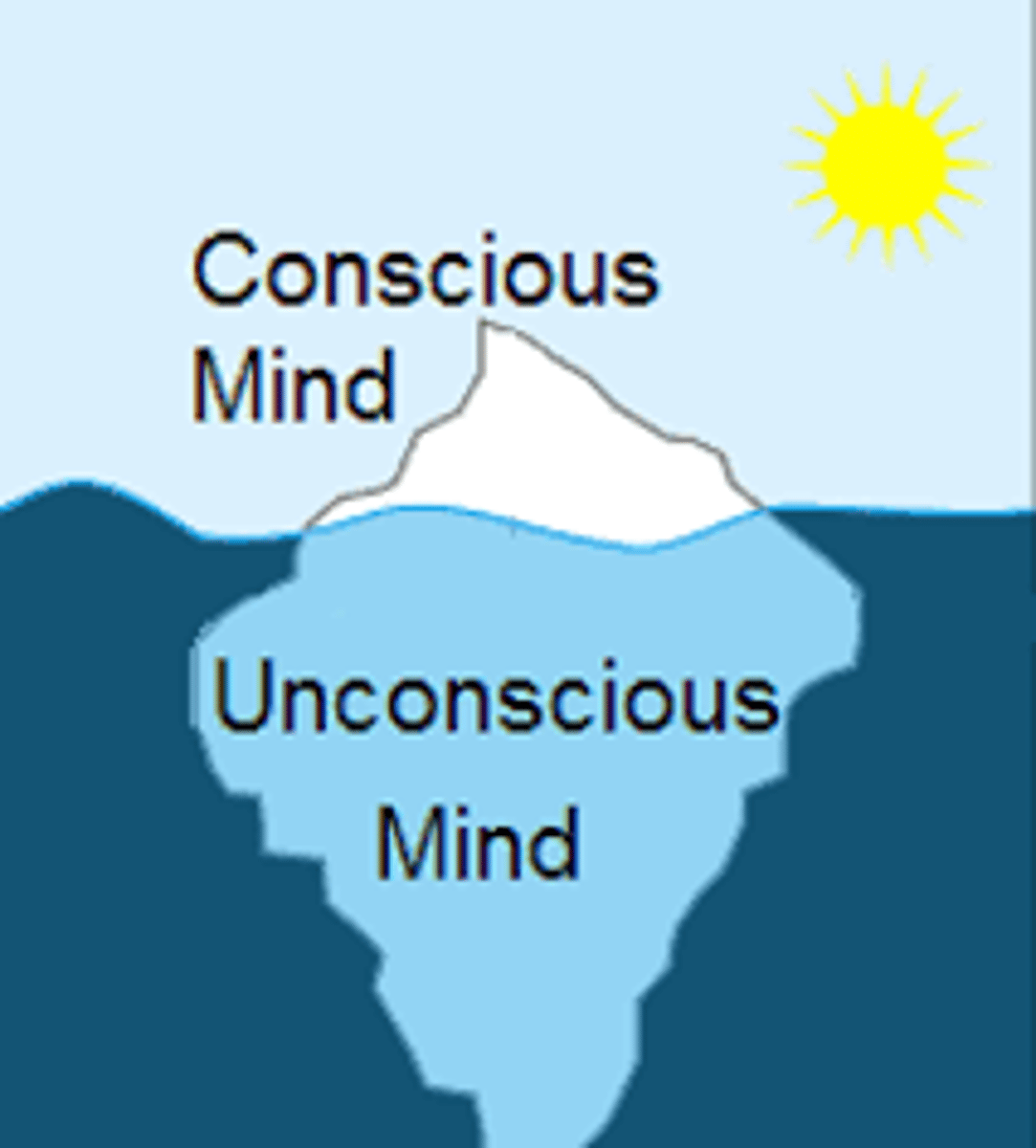
A woman dreams about her boss getting eaten by a giant snake. What might be the manifest content in this example? latent content?
The manifest content is what she saw - her boss getting eaten by a giant snake. The latent content could be her suppressed feelings of anger toward her boss. Perhaps subconsciously she wants her boss to be out of her life.
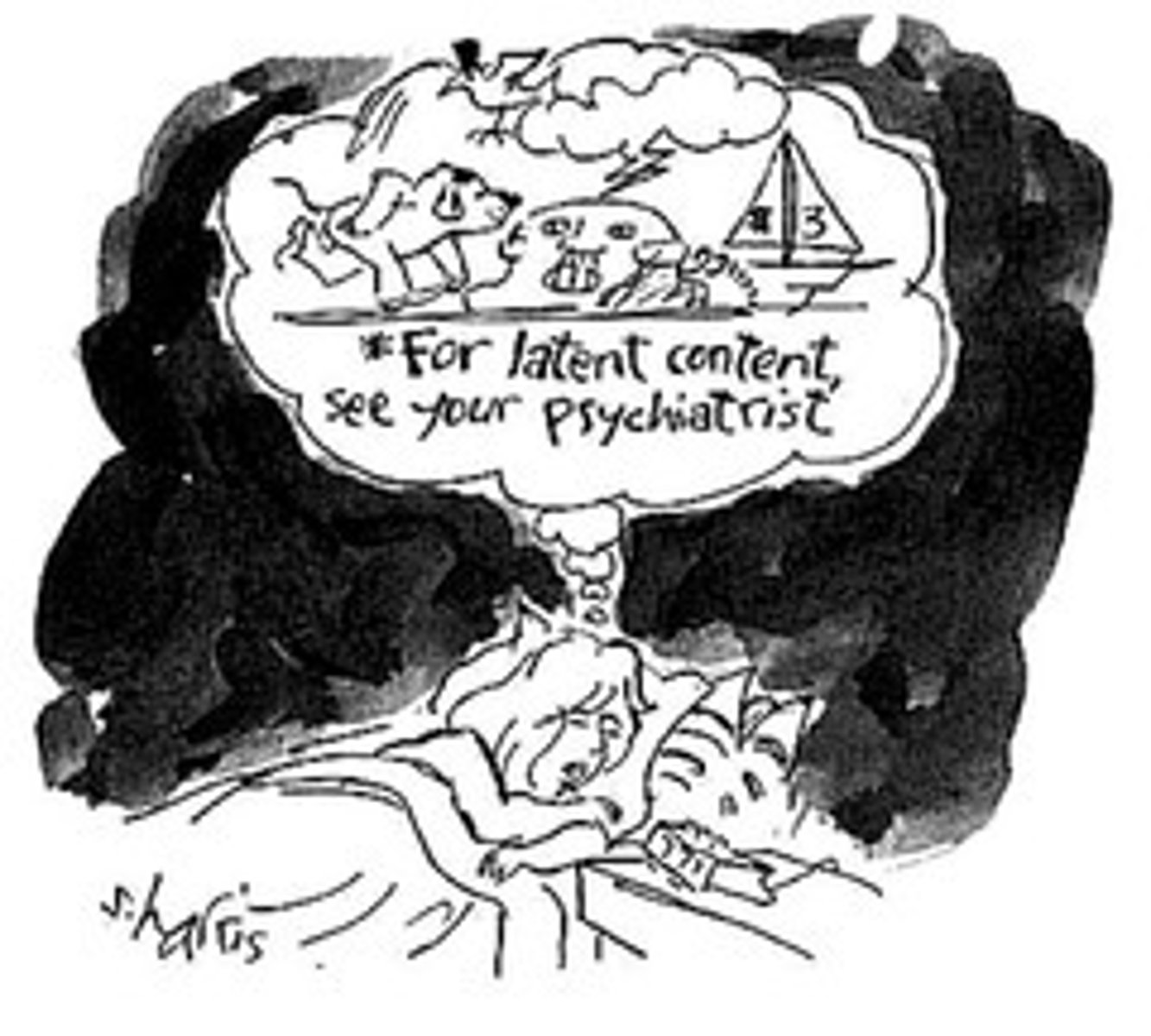
_________________ is a dream theory that explains that dreams equates to the brain activity in our brainstem attempting to be interpreted by the brain's frontal cortex.
(A) Freud's Theory of Dreaming
(B) Evolutionary Biology Dream Theory
(C) Activation Synthesis Hypothesis
(D) Neural Pathway Theory
(C) Activation Synthesis Hypothesis
The Activation Synthesis Hypothesis is a dream theory that explains that dreams equates to the brain activity in our brainstem attempting to be interpreted by the brain's frontal cortex
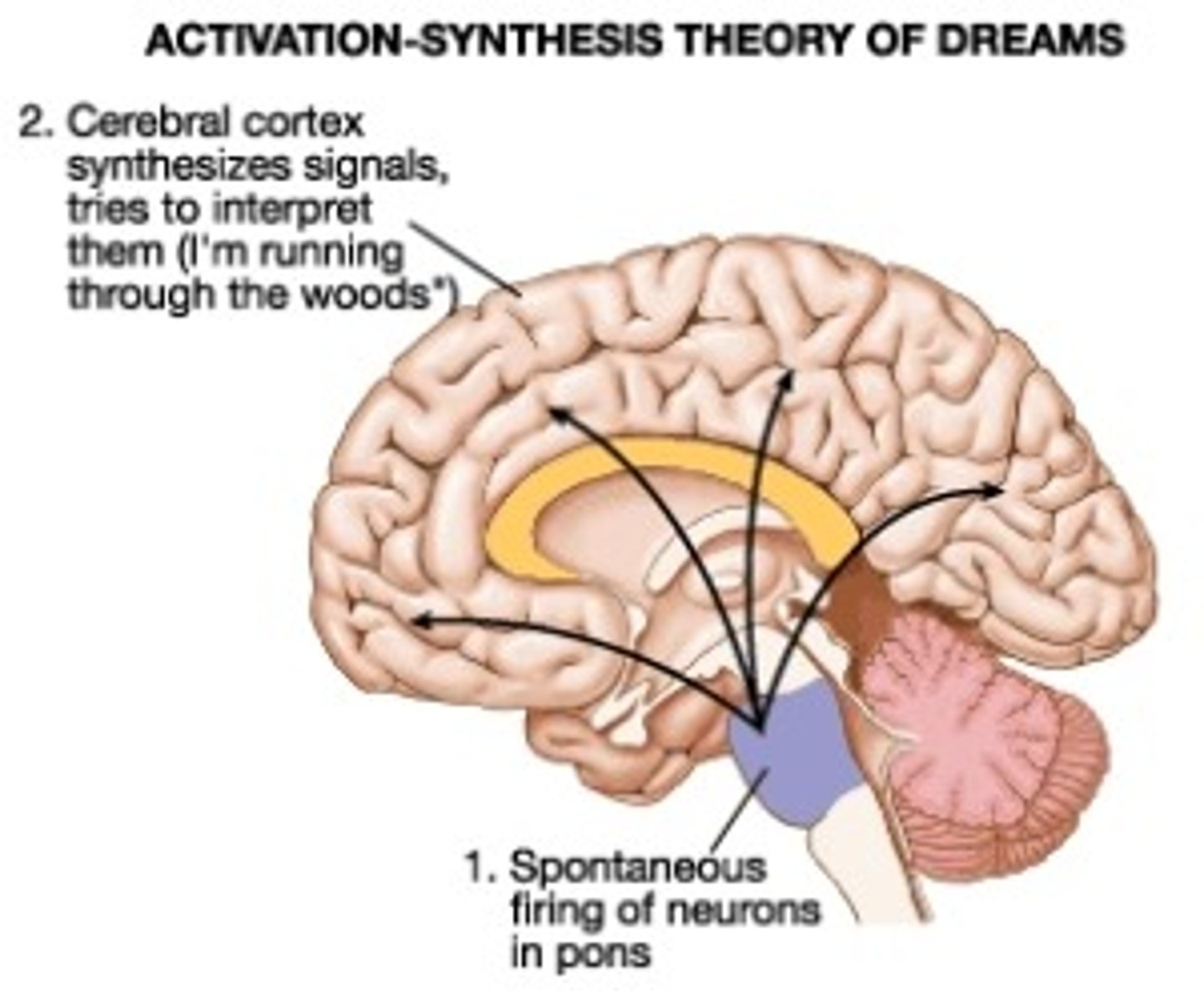
Compare the Activation-Synthesis Dream Hypothesis to the Freud Dream Theory.
Activation-Synthesis: In REM sleep, the brainstem is active and the cerebral cortex will later make sense of it. Dreams are a result of random firing in the brain.
Freud: The manifest content ("plot") has a hidden meaning (the latent content) to be interpreted to resolve hidden problems.
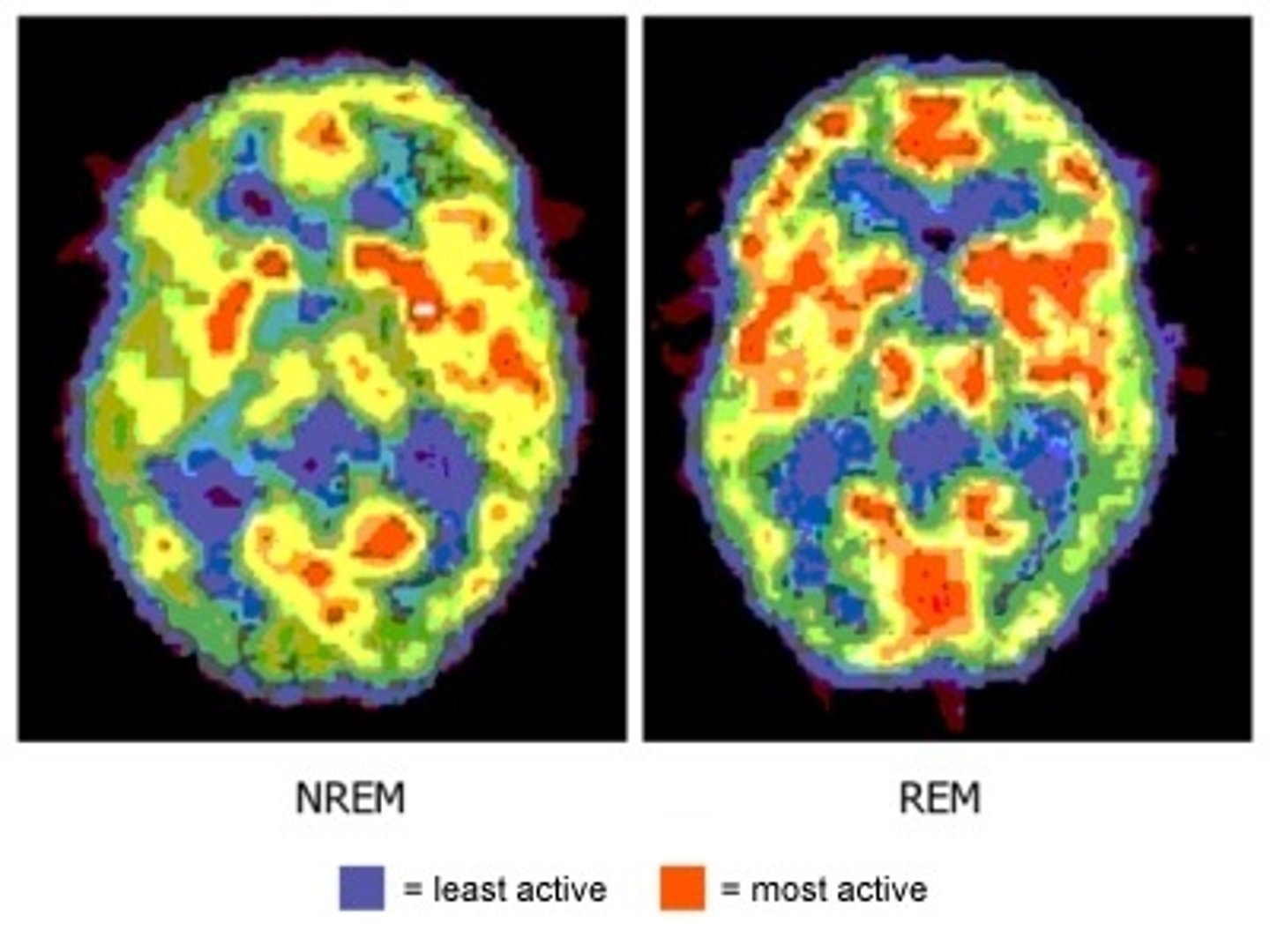
What refers to the persistent difficulty in falling asleep or staying asleep?
(A) Narcolepsy
(B) Sleep Apnea
(C) Insomnia
(D) Sleep debt
(C) Insomnia
Insomnia refers to the persistent difficulty in falling asleep of staying asleep
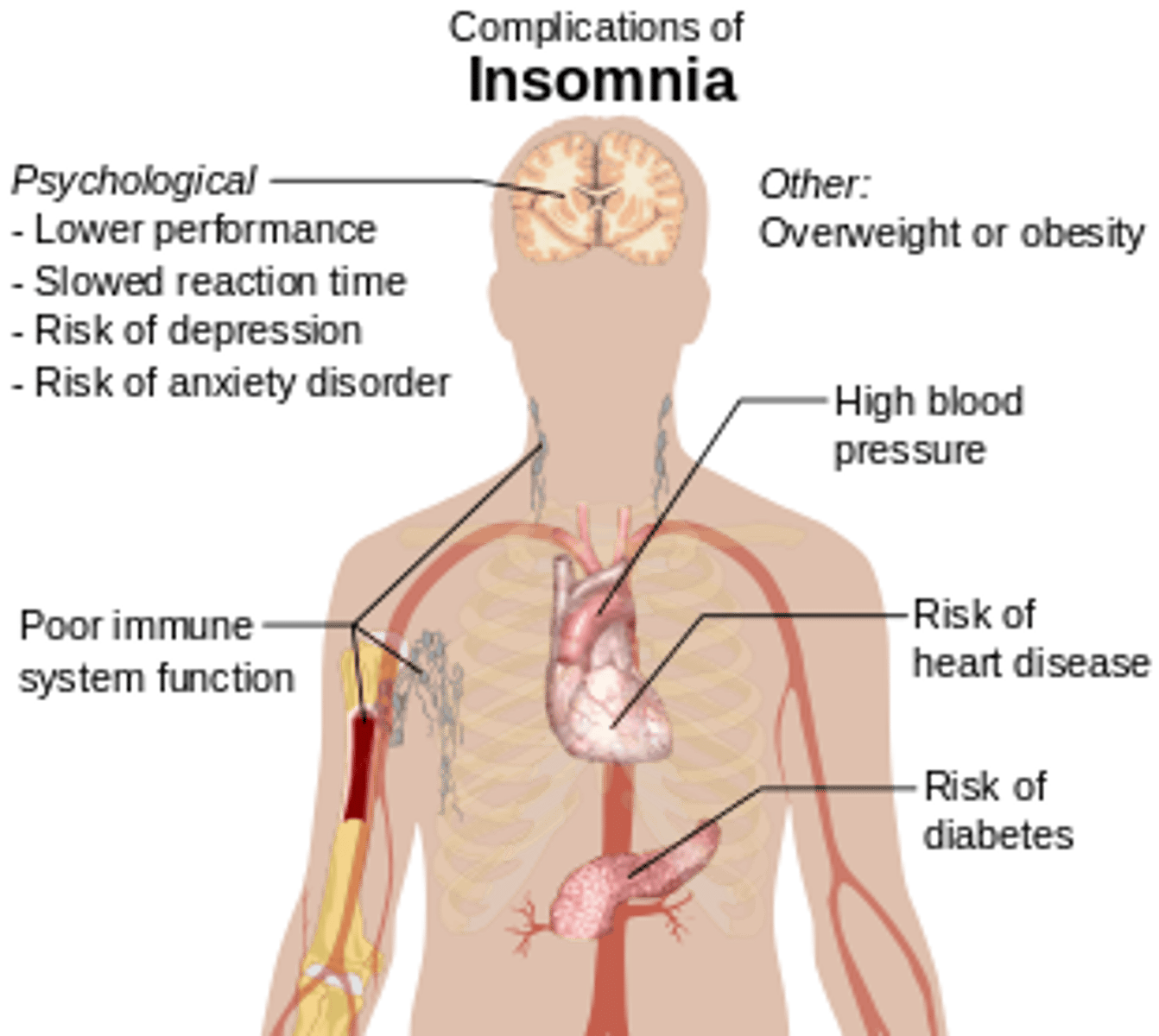
What refers to some people not having the ability to stop themselves from falling asleep, and genetics are strong indicator of this sleep disorder?
(A) Narcolepsy
(B) Sleep Apnea
(C) Insomnia
(D) Sleep debt
(A) Narcolepsy
Narcolepsy refers to some people not having the ability to stop themselves from falling asleep, and genetics are strong indicator of this sleep disorder.
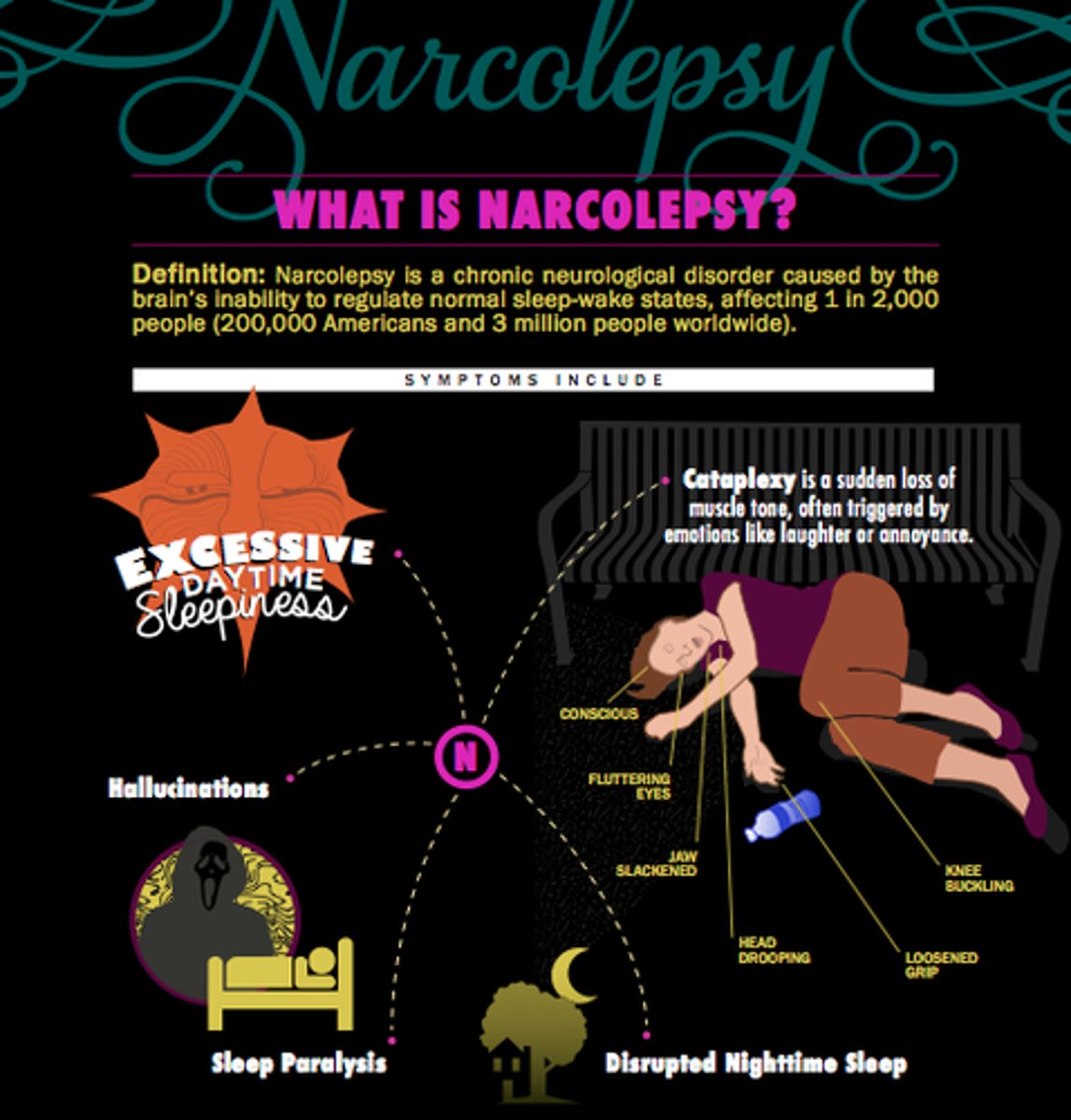
Which sleep disorder refers to people often being unaware they have the disorder? During sleep, one stops breathing multiple times throughout the night and the body ends up not getting enough N3/slow wave sleep.
(A) Narcolepsy
(B) Sleep Apnea
(C) Insomnia
(D) Sleep walking
(B) Sleep Apnea
Sleep Apnea is a sleep disorder that people are often unaware they have. People with sleep apnea stop breathing multiple times throughout the night resulting in the body not getting enough N3/slow wave sleep.
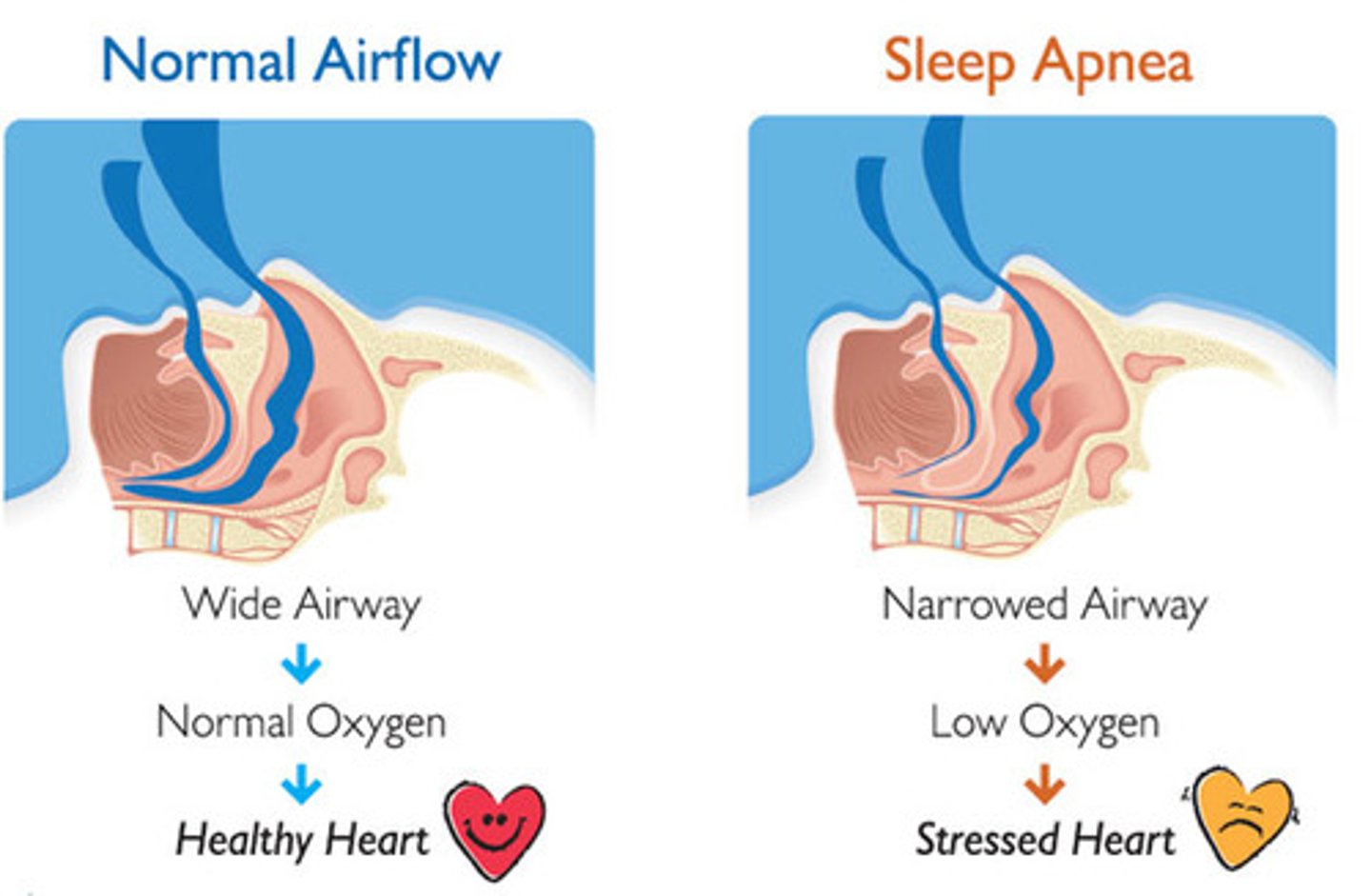
With _______ sleep apnea, the sufferer stops breathing without any clear respiratory tract cause, but rather due to ventilation control system errors. With ________ sleep apnea, there is a clear physical blockage.
(A) Obstructive, Obstructive
(B) Obstructive, Central
(C) Central, Central
(D) Central, Obstructive
(D) Central, Obstructive
With Central sleep apnea, the sufferer stops breathing without any clear respiratory tract cause, but rather due to ventilation control system errors.
Obstructive sleep apnea has a clear physical blockage, like this image.
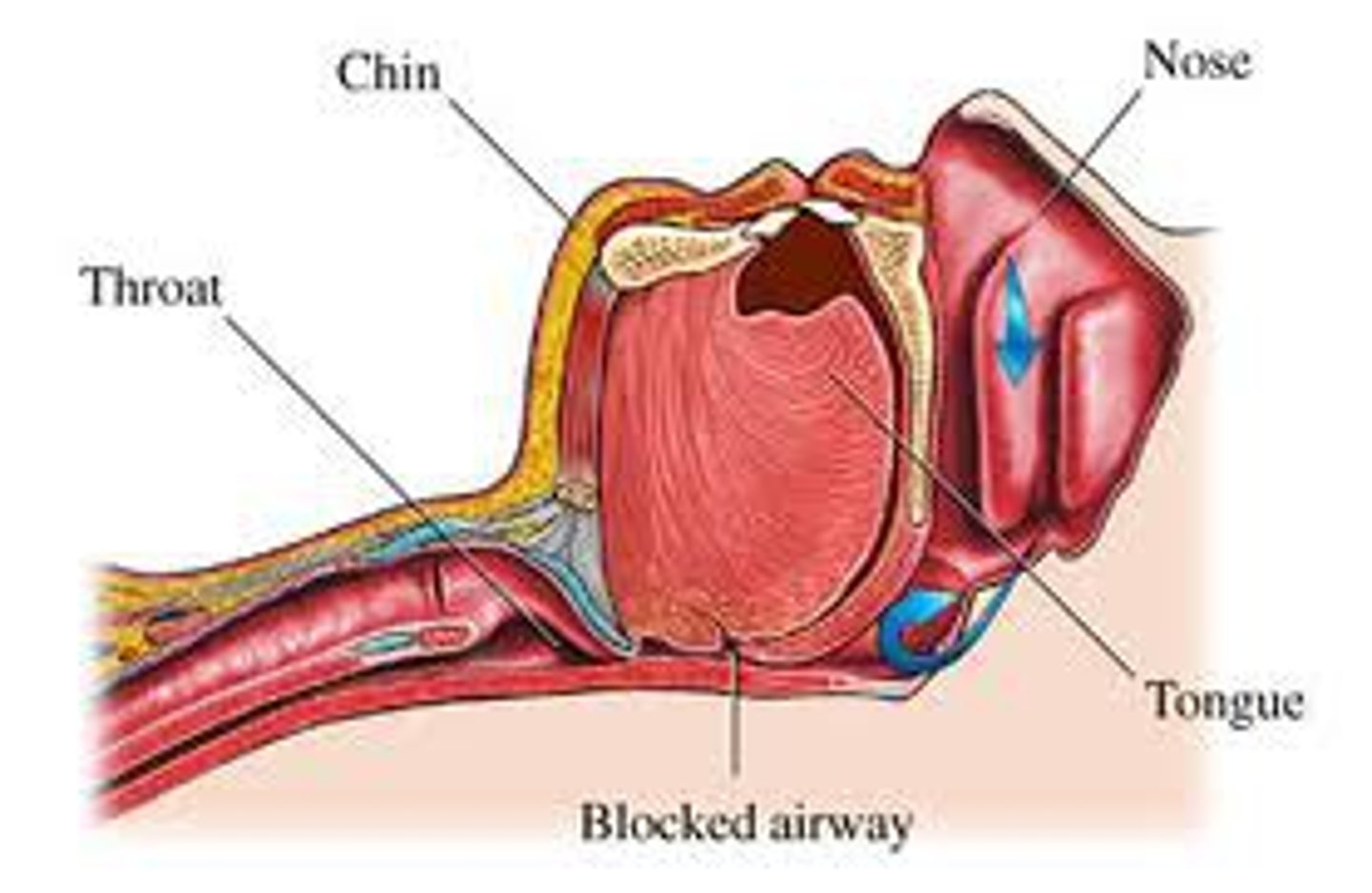
Which sleep disorder primarily occurs during N3/slow wave sleep and is mostly a genetic disorder, that decreases with time?
(A) Narcolepsy
(B) Sleep Apnea
(C) Insomnia
(D) Sleep walking
(D) Sleep walking
Sleep walking is a sleep disorder that primarily occurs during N3/slow wave sleep and is mostly a genetic disorder that decreases with time.

True or False? Hypnosis and Meditation are two examples of Induced States of Consciousness.
True. Hypnosis and Meditation are two examples of Induced States of Consciousness.
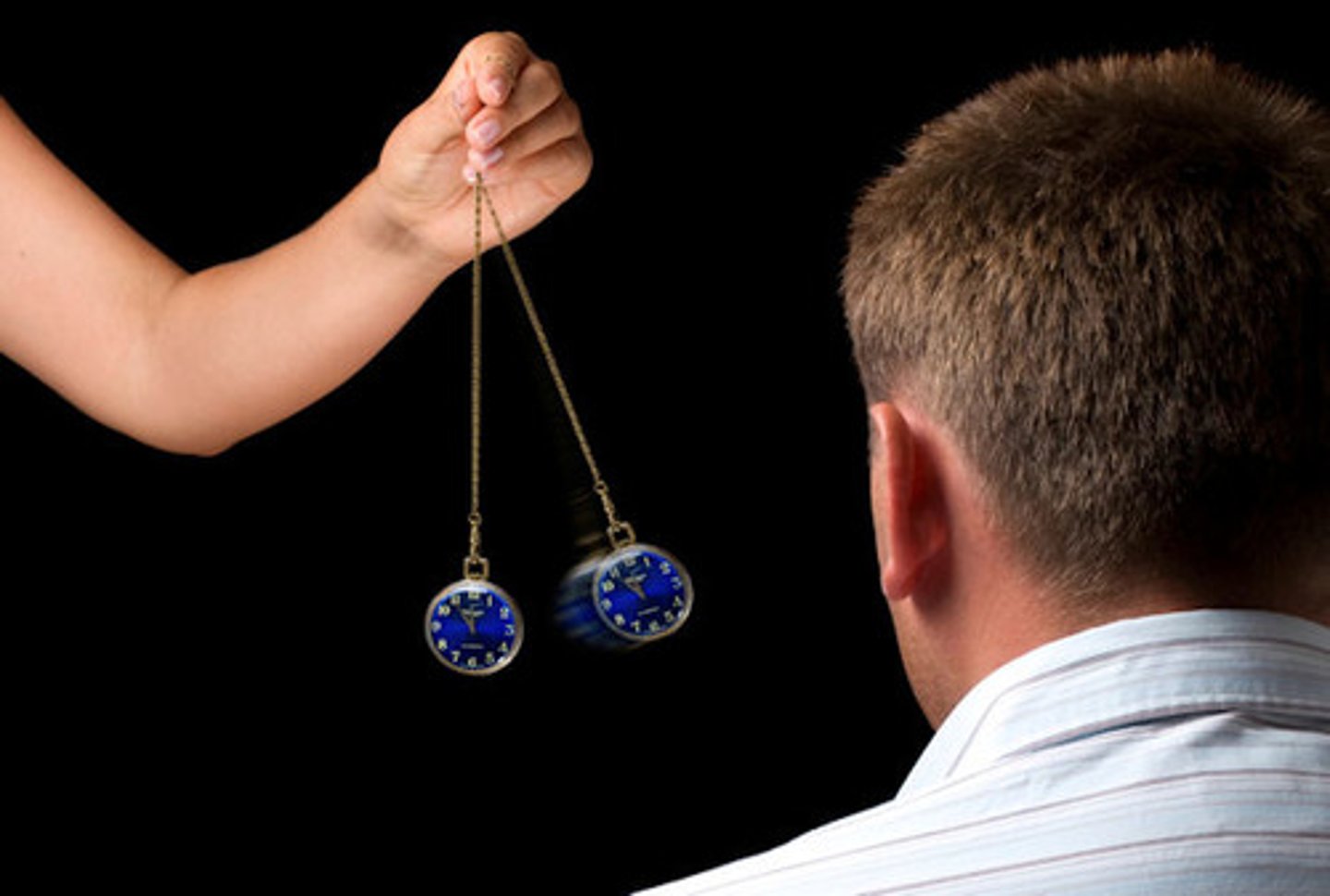
Which form of an induced state of consciousness usually involves getting a person to relax and focus on their breathing, however becoming more susceptible to suggestion in this state?
(A) Meditation
(B) Hypnosis
(C) Insomnia
(D) Narcolepsy
(B) Hypnosis
Hypnosis is a form of an induced state of consciousness that usually involves getting a person to relax and focus on their breathing, however people become more susceptible to suggestion in this state.
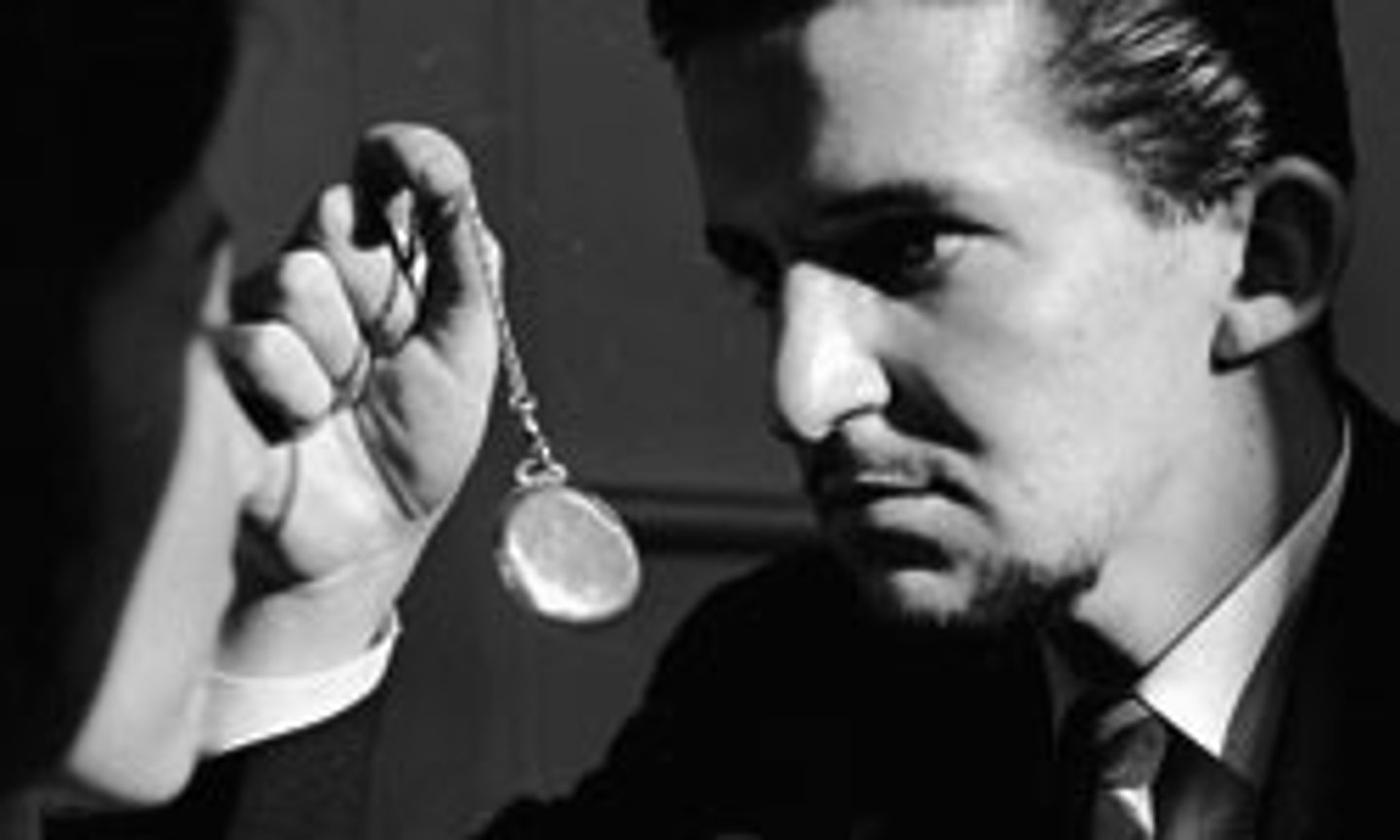
CRB Which of the following CAN hypnosis be effectively used for?
(A) To gain superhuman physical qualities
(B) To remember events dating back to infancy
(C) To construct false memories
(D) To force people to do very extreme actions later on
(C) To construct false memories
Hypnosis can be used to construct false memories by taking advantage of imagination. It does NOT have any of the other effects given as options.
Which form of an induced state of consciousness is used to train people to self-regulate their attention and awareness and can also be used to focus on something particular or act as a time for the mind to wander freely?
(A) Meditation
(B) Hypnosis
(C) Insomnia
(D) Narcolepsy
(A) Meditation
Meditation is a form of an induced state of consciousness that is used to train people to self-regulate their attention and awareness and can also be used to focus on something particular or act as a time for the mind to wander freely.

CRB Mindfulness-Based Stress Reduction is often used in medical settings to alleviate the effects of stress. Which of the following brain waves will it increase during meditation?
I. Alpha
II. Theta
III. Delta
(A) I only
(B) I and II only
(C) II and III only
(D) I, II and III
(B) I and II only
Mindfulness-Based Stress Reduction can increase the occurrence of Alpha and Theta waves during meditation, and somewhat increase them even after meditation ends.
Amaya’s physician diagnoses her with a sleep disorder and prescribes her a drug that increases the amount of norepinephrine in the synaptic cleft. Which of the following sleep disorders does Amaya most likely have?
A) Insomnia
B) Sleep apnea
C) Sleep deprivation
D) Narcolepsy
D) Narcolepsy
Narcolepsy is linked to the deficiency of neurotransmitters involved in alertness, which suggests that stimulant medications (such as those that increase norepinephrine) are appropriate therapies.
Sam is entering a blind-folded taste test. He can taste something bitter, something sweet, a hint of umami, and lots of saltiness. Which taste is not detected by G-protein coupled receptors?
A) Umami
B) Bitter
C) Sweet
D) Salty
D) Salty
Sweet, umami, and bitter tastes are detected by G-protein coupled receptors, while salty and sour tastes are detected through the use of ion channels.
The vomeronasal system contains apical and basal cells. Which of the following statements correctly describes these cells?
I. Both basal and apical cells are found at the beginning of a neural pathway that reaches the amygdala
II. Basal cells have receptors that are sensitive to all pheromones
III. Both basal and apical cells synapse on to the accessory olfactory bulb.
A) I, II, and III
B) III only
C) I and III only
D) I and II only
C) I and III only
Each basal cell and apical cell are specialized, in that they are only sensitive to a subset of pheromones. Both cell types are located within the nasal passage and synapse onto the accessory olfactory bulb, which transmits signals to the amygdala.
Pheromone particles enter the _____. These particles are detected by the ___________, and this structure transmits signals to the ____________.
Pheromone particles enter the nose. These particles are detected by the accessory olfactory epithelium, and this structure transmits signals to the accessory olfactory bulb.